




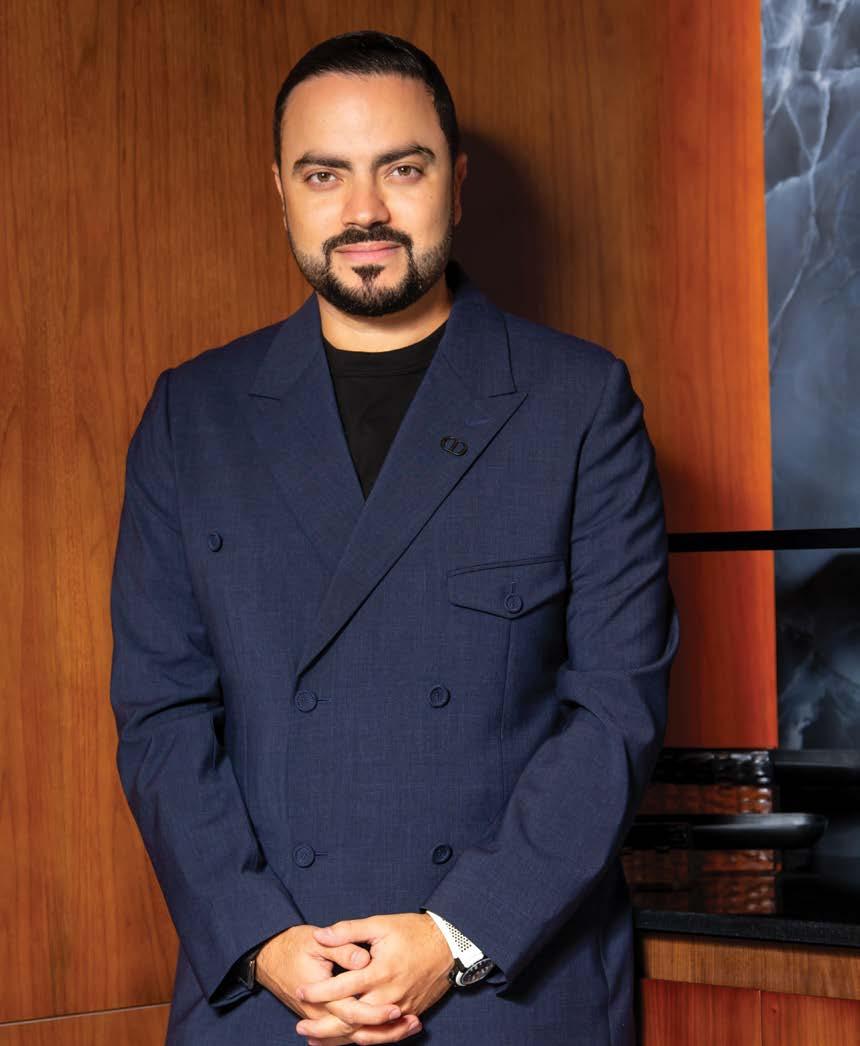



↑ Kirsten Connell, Partner and Head of the First Cheque Fund at Octopus Ventures
20 Future Tested First DR BEN WARNER builds AI tools simulating future decisions for leaders
Tracking Trash How POLYTAG makes recycling visible
The Real Deal
KAMANI’S game-changing property play
44 The First Believer KIRSTEN CONNELL backs bold, earlystage founders 46 From Lockdown to Liftoff The entrepreneur fueling a new wave of founders
How To… …avoid hubris when growing your start-up
From the Ring to the Algorithm LESLEY SACKEY’S journey from Team GB boxer to tech visionary
The Missing Link How leadership and culture fuel innovation 40 Do We Really Want One-Person Unicorns? Why solo-founder unicorns aren’t worth chasing 42 Why Franchising Beats Going it Alone Offering a faster, safer path 8 The Year-End Edge How leaders close 2025 strong and build for 2026 12 No-Frills, Big Thrills Voices championing Britain’s hidden industries
FEATURES EDITOR Patricia Cullen patricia.cullen@bncb2b.com
CEO Wissam Younane wissam@bncpublishing.net
MANAGING DIRECTOR Rabih Najm rabih@bncpublishing.net
ART DIRECTOR Simona El Khoury
EDITORIAL TEAM Tamara Pupic, Aalia Mehreen Ahmed
MEDIA SALES MANAGER Olha Kovalova olha.kovalova@bncb2b.com
GENERAL MANAGER Daniel Malins daniel@bncb2b.com
REGIONAL DIRECTOR Andy B
CONTRIBUTING WRITERS
Jill Williams, Pip Wilkins, Cris Beswick, Yasin Altaf and Dr Christian Hampel
SUBSCRIBE Contact subscriptions@bncb2b.com to receive Entrepreneur United Kingdom every issue. COMMERCIAL ENQUIRIES sales@bncb2b.com
Access fresh content daily on our website

As we approach the end of the year, this November issue of Entrepreneur UK takes a closer look at some of the most exciting developments in the entrepreneurial world. Our cover story features Ali Al Gebely, the visionary founder of ONE Development, who is redefining the real estate landscape. Al Gebely’s innovative approach merges traditional property development with cuttingedge technologies, creating sustainable, forward-thinking solutions. His work demonstrates how even the most established industries can evolve to meet the challenges of the future - and how visionary leadership is crucial in shaping tomorrow’s cities.
Beyond our cover, this issue explores the final stretch of the year for entrepreneurs - those crucial last months when strategic moves are made and businesses push to meet their annual goals. November offers a moment for reflection and action, whether entrepreneurs are preparing for growth in the New Year, securing vital funding, or scaling their operations. We spoke to
entrepreneurs about what they’re focusing on to ensure success as the year comes to a close, and how these last steps set the stage for the future. In addition, we spotlight No-Frills, Big Thrills, a feature that uncovers industries often overlooked but critical to the UK’s economic success. At Entrepreneur UK, we believe it’s time to give these sectors the attention they deserve, especially as innovation is happening in unexpected corners of the economy.
We also hear from Jill Williams, Partner at BGF, who discusses why backing women entrepreneurs is key to unlocking the next wave of UK growth. Supporting women-led businesses is more than a trend - it’s a vital economic strategy that’s reshaping industries, opening new market opportunities, and strengthening the UK’s economic resilience. Also in this issue, Kirsten Connell, Partner and Head of the First Cheque Fund at Octopus Ventures, shares her expertise on turning an idea into an investment. Connell’s insights are invaluable for those looking to navigate the early stages of building a successful business. This Entrepreneur UK issue also features the inspiring journey of Jack Whettingsteel, who went from supermarket night shifts to co-founding HelpBnk with Simon Squibb. These stories, along with many others, remind us of the untold narratives that are quietly driving the UK economy forward. As we close out 2025, let this issue inspire and encourage you to keep pushing boundaries, embracing innovation, and setting yourself up for success in the year ahead. Thank you for reading, and we wish you continued success as you finish 2025 on a high note.
Patricia Cullen
Features Editor, Entrepreneur United Kingdom

How leaders close 2025 strong and build for 2026 by
PATRICIA CULLEN

As the final quarter of 2025 unfolds, businesses find themselves navigating a critical juncture. November, in particular, often feels like the make-or-break month - a time to lock in priorities, sharpen strategy, and rally teams amid mounting pressure. The challenge? Balancing the urgency of year-end goals with the need to build sustainable momentum for the coming year. Across industries, successful leaders share a common approach: they combine disciplined execution with strategic foresight, leverage technology thoughtfully, and protect their teams from burnout by fostering purposeful cultures. We spoke to four CEOs across sectors - from healthcare to private equity, fintech to pension technology - to understand how they’re closing out 2025 and setting up for 2026.
Lyall Cresswell, CEO and founder of Transport Exchange Group (TEG), a technology company that operates digital freight platforms, has learned over 25 years that winning companies are those that “actually finish what they started.” For him, Q4 is “heads down time - making sure we deliver on the strategy we set for the year.” Rather than rushing to patch new initiatives, Cresswell emphasises disciplined focus. “We reinvest 25% of revenue into R&D every year, but we also protect our people,” he explains. “Q4 isn’t about heroics, it’s
about executing the plan we’ve built together. Sustainable growth means sustainable teams.” This balance between focus and team wellbeing is echoed across sectors, underscoring that the path to success comes from steady, deliberate progress rather than rushing without direction.
Technology as a Strategic Enabler
Another key focus is strengthening customer relationships. “Our focus for the final quarter is clear
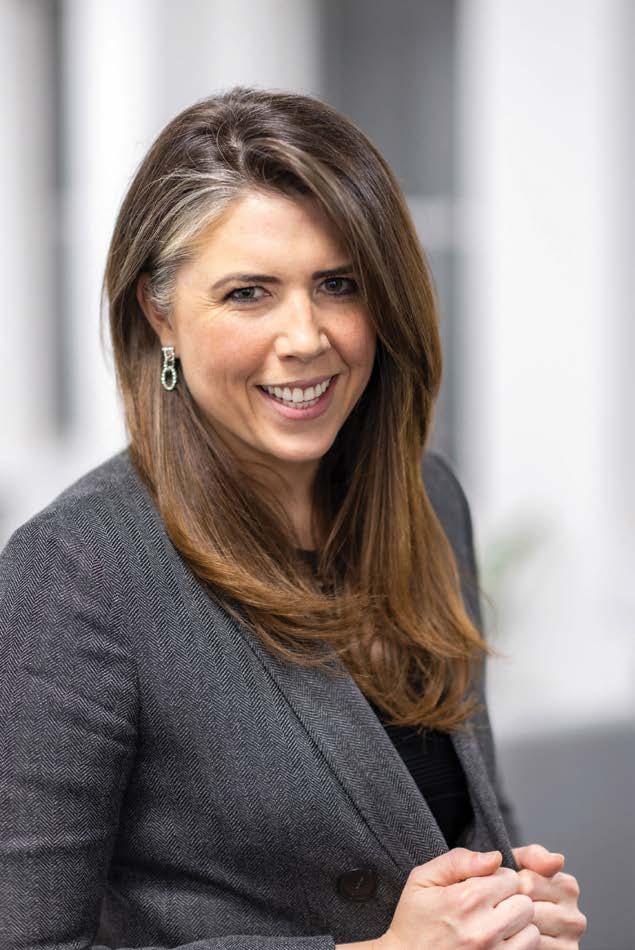
- clients come first. Q4 is always intense, but this year there’s a noticeable lift across the market. After a year of slower deal flow,
activity is finally picking up again. PitchBook data shows PE exits rose across the summer to their highest monthly level of 2025 so far,
→ Carrie Osman, CEO and founder of Cruxy
with new sell-side mandates increasing each month since May,” says Carrie Osman, CEO and founder of Cruxy, a private equity

OUR ADVANTAGE COMES FROM SOLVING REAL PROBLEMS THAT OUR CUSTOMERS ACTUALLY FACE - THE PAYMENT CHALLENGES THAT HAVE CONSTRAINED LOGISTICS OPERATORS FOR DECADES. DELIVERING GENUINE VALUE AND BUILDING LASTING RELATIONSHIPS CREATES SUSTAINABLE

growth intelligence firm. The role of technology in closing the year and sprinting ahead into 2026 was also a strong theme. Osman highlights how tech powers competitive advantage.
“We refuse to treat technology as a buzzword. Our proprietary Cortex platform is the backbone of how we deliver data-first insights that shape smarter client decisions.” The other side of that equation is their people. “Standards matter. No matter how fast we grow, our culture of accountability, drive to impact and excel-
lence remains non-negotiable. The ‘Cruxy way’ means showing up curious, consistent, and committed - that’s how we stay ahead of the curve.” Looking forward, Osman says Cruxy is “doubling down on how we leverage AI to drive both performance and value - not just efficiency, but intelligence.” This mindset of harnessing AI not simply for automation, but to deepen insight and drive smarter outcomes, also resonates with Vivan Shridharani, co-founder and CCO at Raindrop, the pension-finding platform.
Shridharani describes a deliberate push to “increase our technological, operational, and business investment in AI to deliver the enhanced features clients need.” This investment supports their mission to reunite savers with lost pensionsover £800m recovered so far - and sets the stage to surpass the £1bn mark soon.
Customer-Centricity as the North Star
Despite technological leaps, the laser focus on real customer problems
remains paramount. Cresswell underscores this by highlighting TEG’s competitive edge: “Our advantage comes from solving real problems that our customers actually face - the payment challenges that have constrained logistics operators for decades. Delivering genuine value and building lasting relationships creates sustainable differentiation.”
Similarly, Jon Robinson, CEO of medical cannabis company Mamedica, talks about how patient needs are driving their year-end focus. “Our patient base has grown by over 100% in the last year. Our priority is strengthening our digital healthcare platform to make access to treatment even more seamless. This also involves optimising our supply chain to maintain an uninterrupted source of high-quality CBPMs for our growing number of patients.” Robinson is doubling down on accessibility as a key strategic lever: “Following our recent funding round, we’re introducing a lower-cost pricing model to make treatment more affordable. We aim to stay ahead not by cutting corners, but by widening access - proving that premium clinical care and affordability can coexist.” Robinson points out that “November always feels like the sprint before the finish line,” yet for them, it’s really about preparing the pace for the year ahead.
End-of-year pressures can be intense, but all four leaders emphasise the importance of sustaining their teams through this demanding period. Osman describes how Cruxy manages the relentless Q4 pace: “We encourage the team to zoom out and see the bigger picture - the progress made, lessons learned, and opportunities ahead. That perspective turns fatigue into focus. Our Friday team drinks aren’t just social - they’re a reset.” Shridharani adds how Raindrop’s culture of collaboration is key to
maintaining motivation and innovation under pressure: “We are in constant dialogue with our team, fostering a collaborative environment that encourages feedback across all levels. Recently, we held a company-wide hackathon empowering team members to take leadership roles — many winning ideas are now part of our product and strategic roadmap. This helps colleagues to see the impact of their effort and continued innovation.” At Mamedica, Robinson acknowledges that working in healthcare means the stakes are always high and he

stresses compassion: “Our dedicated team supports patients with chronic conditions who rely on consistent care all year round. I feel like our entire team takes that responsibility deeply, and that’s what keeps everyone focused rather than fatigued.” He goes on to say that the team works hard, celebrates wins, stays flexible, and values empathy as much as ambition. Cresswell echoes this sentiment with a warning. “When you’re building for the long term you can’t afford to burn people out.”
All leaders share a conviction that Q4 is not just a frantic dash, but a strategic sprint that sets the tone for the year ahead. As Osman puts it: “We don’t just want to finish the year well - we want to start the next one already ahead.” With smart tech investments, customer-first thinking, and a strong culture that balances ambition with care, these companies are not just surviving the year-end crunch - they’re using it to build lasting advantage. End-of-year planning requires more than crossing off tasks; it demands disciplined execution, strategic foresight, and a relentless focus on the human element. As these leaders show, by aligning technology, customer needs, and team wellbeing, companies can close 2025 with strength and step into 2026 ready to lead.
From private equity founders to AI pioneers embedded in traditional sectors, this Entrepreneur UK feature brings together voices championing the hidden industries driving Britain’s economy - and why they deserve more attention. by
PATRICIA CULLEN
They’re not betting on buzzwords or billion-dollar valuations. Instead, three thirty-something entrepreneurs are finding returns in Britain’s ‘unsexy’ foundation - and proving that the overlooked might just outperform the overhyped. In an era where headlines celebrate unicorns and the startup world fixates on AI, crypto, and the next disruption, three entrepreneurs are doing the opposite. “When we say ‘unsexy,’ we don’t mean unimportant,” says Grégoire Louisy, co-founder of Tioopo Capital, a private equity firm based in London. “We mean industries that are profitable, cash-flowing, and critical in the value chain, but they don’t fit the VC narrative or catch headlines.”
Founded by Grégoire Louisy, Cyril Aboujaoude, and Shahan Sarkissian, Tioopo Capital may be one of the youngest private equity firms in the UK, but it’s already making a name for itself as a bit of a maverick. Their strategy is as straightforward as it is

unusual: forget the shiny tech and invest in sectors most investors ignore.
That means family-run manufacturers, advanced engineering firms, and niche industrial suppliers. Some call them low-profile businesses. Others might call them boring. Tioopo calls them an opportunity.
“When we started Tioopo Capital, our strategy of investing in unsexy businesses was a calculated bet - better risk-adjusted returns,” says Aboujaoude. “A few years later, Tioopo has gone from one company and 20 employees to seven portfolio companies and over 500 employees through its portfolio companies. It shows the sheer growth potential of backing industries that most investors overlook.”
While their peers chase blitzscaling start-ups hoping to turn losses into future profits, Tioopo’s founders focus on companies generating real cash from day one.
“That allows us to compound value year after year, deleverage over time, and deliver strong returns even without an exit,” explains Louisy. “Too many younger investors are skewed towards venture capital, where companies live off raised money and hope one day to become profitable. We’ve always believed the essence of business is to be profitable from the start. It sounds obvious
- but it makes us contrarian in today’s market.” This approach is not just about preference - it’s strategic. It’s about building resilience in an increasingly volatile economy. “We’re not VCs, we’re a private equity firm the way it was intended - operational and hands-on,” says Aboujaoude. “Our north star is risk-adjusted returns - generating VC-like outcomes with far less downside.”
The hard yards
These are not businesses you can toss money at and forget. And that’s precisely why most investors stay away. “The reason others miss it is because it’s hard work,” says Sarkissian. “You can’t just write a cheque and wait. These companies require operational bandwidth, energy, and real involvement. But if you’re willing to roll up your sleeves, you can unlock extraordinary value.” It’s this kind of value that Tioopo believes the UK economy can’t afford to ignoreand that policy makers rarely acknowledge.
“Unsexy businesses may not grab headlines, but they are the backbone of the economy,” says Aboujaoude. “Think about advanced engineering firms, medical device suppliers, or heritage leather producers. They’re often SMEs, but more importantly, they’re the businesses that keep
supply chains running and employ millions. Their growth is critical to GDP - but many face succession risk or stagnation if no one invests in them for the long term.” That long-term mindset means Tioopo takes an unusually hands-on approach. It’s not uncommon for them to embed team members directly into portfolio companies to drive transformation from within. Their playbook is detailed: upgrade leadership, streamline operations, impose financial discipline - and bring in tech. “Every single one of our portfolio companies has at least one AI integration project running today,” says Sarkissian. “Technology is about survival, not just value creation,” says Louisy.
Investing in staying power
When asked what separates a business worth investing in from one that isn’t, Louisy doesn’t hesitate. “We ask: will this business still matter in 10 years? Does it solve a critical problem for customers? Does it have pricing power, sticky relationships, and a product or service that can’t easily be replaced? If the answer is yes, then we know the fundamentals are there.” It may sound like old-school business logic - but that’s the point. In a market obsessed with the new, Tioopo is making the case for the enduring. “We ask: ‘Can this reliably compound capital and grow stronger year after year?’” says Aboujaoude.
“
UNSEXY BUSINESSES MAY NOT GRAB HEADLINES, BUT THEY ARE THE BACKBONE OF THE ECONOMY. THINK ABOUT ADVANCED ENGINEERING FIRMS, MEDICAL DEVICE SUPPLIERS, OR HERITAGE LEATHER PRODUCERS. THEY’RE OFTEN SMES, BUT MORE IMPORTANTLY, THEY’RE THE BUSINESSES THAT KEEP SUPPLY CHAINS RUNNING AND EMPLOY MILLIONS”

“That’s what sets us apart.”
The future, they argue, won’t be built solely by unicorns and headlinegrabbing founders. It will be shaped by the oftenignored firms that power Britain’s manufacturing base, supply chains, and skilled jobs.
“If these companies don’t adapt, they risk disappearing,” warns Louisy. “Our role is to make sure they evolve - preserving their strengths while making them competitive for the future.” It’s not just talk. In several cases, founders of acquired businesses have reinvested alongside Tioopo - a rare show of confidence. “We’ve seen founders get so excited about the bolt-on
acquisition strategies we introduced that they reinvested alongside us,” says Sarkissian. “We’re giving these companies tools and visions they might never have considered on their own.” There’s a satisfaction that comes from making things work that others have ignored. That, ultimately, might be what drives this unorthodox trio more than returns or recognition. “It really is an adapt-or-die situation,” says Aboujaoude. “The principle is the same: help them modernise, stay relevant, and grow. When they thrive, the whole economy benefits.” And for Tioopo Capital, that’s exactly the kind of headline worth chasing.
Tioopo’s embrace of underappreciated industries is echoed by innovators working directly within these overlooked sectors. The construction industry, despite its massive global impact, often gets dismissed as an outdated, inefficient sector. As Qflow founder Jade Cohen puts it, construction is often seen as a ‘dirty’ space, which has led to it being overlooked for technological innovation. However, this perception actually presents a significant opportunity to drive change. Cohen and her co-founder Brittany Harris, both with firsthand experience in the sector, quickly saw how “chaotic,
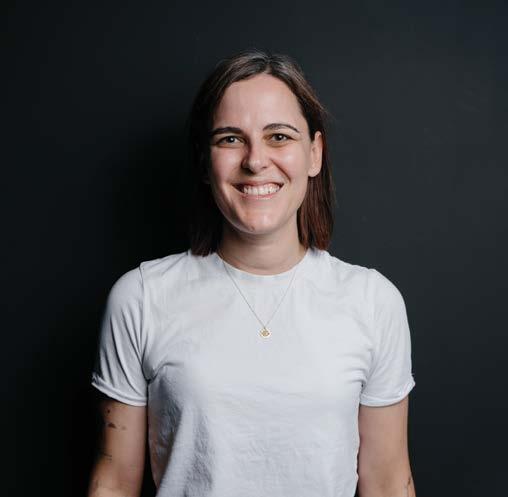
disjointed and disconnected” the industry is, yet realised that “it really didn’t need to be that way.” The problem isn’t the lack of skill - construction is filled with some of the “world’s greatest problem solvers,” but, as Cohen highlights, these experts are often “working under extreme, very tightly constrained circumstances.” Cohen explains that construction is “responsible for some of the most resource intensive activities out there, the most carbon intensive, the most wasteful,” much of which is completely avoidable and stems from simple, preventable errors. Recognising this gap, Cohen and Harris set out to tackle the industry’s data problems with their platform, Qflow. “We thought, ‘we’re best-positioned to look at this issue of poor data and the impacts this can have,’” Cohen notes. The platform’s goal is to bridge the gap between information-rich, data-poor construction sites, aiming to reduce waste, decarbonise, and improve efficiency. One of the challenges Cohen faced was breaking into such a “slow-moving” and “traditional” sector, but Qflow’s approach was designed to be a “light touch,” integrating smoothly into existing workflows. It’s as simple as having workers “take photographs of delivery tickets that they’re already receiving,” which helps avoid a full
→
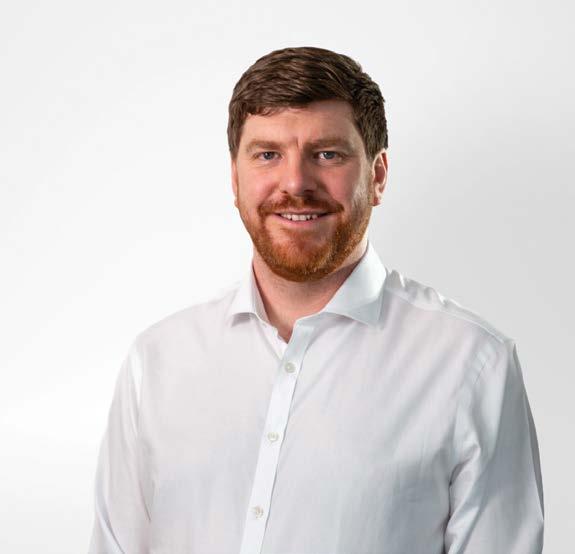
disruption to the system. Looking ahead, Cohen believes AI has huge potential to revolutionise the industry, adding that, “we’re only scratching the surface with what it can deliver,” especially when it comes to rethinking how buildings are constructed and materials are reused.
Tom Bartley, Director of Civil Infrastructure at Oxford University spin-out Mind Foundry, explains how AI is transforming the ageing infrastructure sector - a trillion-dollar global challenge often ignored by start-ups. “The
infrastructure we all rely on every day is ageing. Bridges, tunnels, water networks, and coastal protections are all approaching the end of their design life and starting to show signs of failure,” he says. “At Mind Foundry, we’re building an AI-enabled predictive maintenance platform to help owners manage their asset risk more effectively and make the case for the funding they need to keep people and the economy safe and secure.”
Bartley highlights the uphill battle of building tech businesses in such traditional fields. “The non-software half of our
team all have our roots in civil engineering. We understand that building a tech business in the sector can feel like an uphill battle, but we also know that when customers do sign up, they’re in it for the long run.” Predictive maintenance AI tools help surface risks by integrating sparse and fragmented data, using computer vision to quantify deterioration, and building predictive models that allow engineers to prioritise repairs within tight budgets. “The real challenge is that the owners can’t see or quantify their risks. Data on asset condition is
sparse, subjective, and fragmented, so engineers have to rely on their intuition,” Bartley explains. “We’re using AI to surface risk by integrating and cleaning data, utilising computer vision to quantify deterioration, and building predictive models that enable engineers to compare risk and prioritise within extremely limited budgets.”
By partnering closely with industry experts, Mind Foundry has avoided speculative tech-building, instead validating their ideas with real customers and innovation funding before scaling. “We have a stellar team of engineers, scientists, and designers, so the proof points in these prototype projects had enough wow factor for customers to commit,” Bartley says. “It’s a trillion-dollar global challenge - and we’re building the leading AI solution for the global ageing infrastructure crisis.”
Tech meets tradition in the legal sector
Likewise, Charlie Harrel, CEO of Opus 2, another example of innovation in a modest sector, shares how legal tech start-ups are integrating AI into established industries that many start-ups avoid. “Opus 2 was founded more than 15 years ago by lawyers and seasoned legal technology experts,” Harrel says. “We focus on creating tools that help lawyers work smarter, not just faster.” As AI has matured, Opus 2
WE ASK: WILL THIS BUSINESS STILL MATTER IN 10 YEARS? DOES IT SOLVE A CRITICAL PROBLEM FOR CUSTOMERS? DOES IT HAVE PRICING POWER, STICKY RELATIONSHIPS, AND A PRODUCT OR SERVICE THAT CAN’T EASILY BE REPLACED? IF THE ANSWER IS YES, THEN WE KNOW THE FUNDAMENTALS ARE THERE”
has embedded AI features directly into their case management software, helping lawyers analyse and summarise large collections of legal documents faster. “For example, reviewing and summarising a 75-page transcript used to take around four hours. Opus 2’s AI delivered near-instant results allowing the lawyer to spend just a few minutes reviewing and validating the results,” he says. The legal sector’s cautious and competitive nature means trust in AI is critical. Opus 2’s approach is to create a secure environment with human oversight to reduce risk. “We don’t ask clients to change how they work,” Harrel says. “We’ve built technology that fits naturally into their existing workflows. By showing that AI can be a trusted assistant, we’ve been able to build confidence and adoption.” Looking forward, Harrel believes AI will become integral to legal work, shifting the conversation from ‘Are you using AI?’ to ‘How do you use AI?’ “The firms that succeed will be those that combine trusted technology with human expertise - and that’s exactly where we’ve always aimed to be,” he says.
Together, these stories uncover a striking truth: the future of success and innovation is rooted not only in the flashy or fashionable, but in the unassuming industries that form the bedrock of our economy. While they may lack glamour, these sectors - armed with determination, expertise, and the transformative force of AI, are reshaping the landscape, driving sustainable growth and delivering enduring value. It is here, in the unsexy yet indispensable, that real progress is being made.
→ Charlie Harrel, COO of legal technology and services company, Opus 2




Across the UK, women are launching businesses in record numbers - in 2023 alone, 164,000 new firms were founded by women, accounting for 18% of all new companies. What’s more, nearly half (47%) of early-stage entrepreneurs in the UK are women. The stats are growing and they’re compelling. The fact is, these ventures are transforming industries, creating jobs and rewriting what leadership looks like. But behind those success stories lies a persistent truth: female founders still receive only a fraction of the support and funding available to their male counterparts. The imbalance is holding back not just women, but the growth potential of the UK economy as a whole.
And yet when women do receive the right backing, the results can be transformative. Take Kids Planet, for example, born from one mother’s desire for flexible childcare, it’s grown into one of the UK’s fastest-scaling nursery groups. It’s a story that shows exactly what’s possible when female entrepreneurship meets access to growth capital as well as targeted scale up support. The numbers say everything about the phenomenal success of Kids Planet: 235 nurseries, 7,000 employees and 36,500 children under its care. At
the time of writing, those numbers were correct. However, such is the pace of growth at Kids Planet that they need updating on a regular basis.
While Kids Planet is an excellent example of female-powered growth, supported and accelerated by external investment, the need to build on the growing numbers of female entrepreneurs, create more balance and unlock greater potential in the UK business landscape remains a priority. The good news is, there is clear movement towards addressing the gender divide and the pot of funding being committed to support women in business is starting to fill up. So where is that money coming from?
Earlier this year, BGF announced a £3bn UK-wide commitment to support high-potential companies over the next five years. As part of this pledge, BGF is committing at least £300m to the Invest in Women Taskforce’s funding pot, to support scaling femalepowered businesses. The IWT’s ‘Women Backing Women’ fund, supported by Chancellor
Rachel Reeves, has got some serious financial clout and demonstrates a shift in thinking. In fact, according to the IWT, if women started and scaled businesses at the same rate as men, it would deliver a potential £250bn boost to the UK economy. It’s clear why the organisation is on a mission to create the world’s largest investment pool for female-led and mixed businesses.
But it doesn’t stop there. FFinc, an association dedicated to the financial, career and personal advancement of women, has already built year-long tech accelerators with KPMG, supported hundreds of women to grow businesses globally with HSBC, and helped 20% of its most recent accelerator cohort to secure funding. In September, the organisation launched its latest female-powered venture: the Forward Faster Accelerator – a comprehensive six-month programme designed to supercharge 100 of the UK’s most ambitious female-founded businesses. Backed by BGF and a host of partners including HSBC, the aim is to move beyond traditional mentorship, to deliver capital access, commercial readiness and strategic scale support. The funding landscape for scaling female-led business is gathering pace, with a concerted effort from the investment community and wider stakeholders to support the growing number of businesses founded by women, building on the 164,000 started in 2023.
There is clearly a growing appetite to invest, and there are countless female entrepreneurs waiting in the wings ready to supercharge their business. But, after years of underservice, how can they make the most of that relationship when the time comes? Regardless of whether a founder is male or female, securing investment for the next stage of a business’ growth takes preparation.
REGARDLESS OF WHETHER A FOUNDER IS MALE OR FEMALE, SECURING INVESTMENT FOR THE NEXT STAGE OF A BUSINESS’ GROWTH TAKES PREPARATION. FEW ARE INVESTOR-READY FROM THE OUTSET. THE FIRST STEP IS TO CONSIDER WHAT INVESTORS LOOK FOR IN A BUSINESS”
Few are investor-ready from the outset. The first step is to consider what investors look for in a business. Generally, it’s a strong management team, good financial performance and a well-thought-out growth plan, among other things. Businesses typically seek investment to finance growth through expansion, which may include research and development into new propositions, hiring people, or to finance the costs of launching in a new market. Alternatively, the investment may be required to fund growth using a buy-and-build acquisition strategy. Whatever the driver, there are a number of key things to consider when preparing for investment:
}Growth plans: Whatever a business’ growth strategy, it should be underpinned by a detailed step-bystep plan, which should be supported by as much evidence as possible.
}People: An investment is a relationship, and relationships depend upon people. A robust growth plan should identify the leadership, technical and professional skills of the top team. Investors must have confidence that a business has the right people to deliver their growth plan.
}Credible financial plan: The due diligence stage of the investment process is crucial for determining success or failure. If financial accounts and supporting analysis are in the wrong format, insufficiently detailed, or in any way non-compliant with legislation, no one will want to invest.
}The right investor: While the pool of investors with a specific femalefocused remit is still in its infancy, there are many investors on the market willing to fund high-poten-
tial businesses. Some have specific expertise in market sectors, some are generalists, some are known for seeking returns in a short timeframe, others are more long-term in nature. Businesses should aim to engage with those that are a good fit for their business – alignment around goals is key.
}Timing: If everything falls into place and is aligned, a small number of nimble and well-managed businesses are able to achieve investor-readiness in a few months. However, a timeframe of at least three to six months is more common, possibly up to 12 or more if a business has a lot of work to do.
More than money
The statistics tell us that the business landscape is changing in the UK and women are right at the centre driving that growth. However, there is still work to be done to create more inclusive entrepreneurship, and a more equitable, dynamic future for female-powered businesses. Capital alone isn’t enough to drive growth. Networks, community and visibility for female business leaders are crucial.
Collectively, we need to do more to increase female representation on boards and nurture successful mentor-mentee relationships. It is a challenge that has been accepted and the time to power diversity in the growth economy is now.

Jill Williams is a Partner at BGF – the UK and Ireland’s most active growth capital investor . BGF has been recognised as the #1 investor in female-powered scale-ups in the UK over the last five years.

Dr Ben Warner is co-founder of Electric Twin and helped shape COVID policy in Downing Street. Now he’s building AI tools that let leaders simulate the future - before making a single decision. by
PATRICIA CULLEN
In the world of leadership, timing is everything. Make the right decision too late, and it can feel like no decision at all. Make it too early - without data or foresight - and it risks being disastrously wrong. During the COVID-19 pandemic, Dr Ben Warner, a theoretical physicist turned government advisor, sat at the centre of this tension. “During COVID-19, they tried to base as many decisions as possible on data,” he says. “They were doing their best to follow the science. But sometimes, the sort of information and data just wasn’t there, and they had to rely on their own gut feeling.” That reliance on instinct - necessary but risky - in the absence of real-time evidence drove Warner toward a question that has since become his life’s work: What if leaders could test decisions before they even made them?
Building a Twin for the Real World
Now co-founder of Electric Twin, a London-based company that develops synthetic populations and tools to simulate human behaviour, Warner’s answer to that question is unapologetically ambitious. The start-up builds software that allows organisations to simulate real-world decisions in real time, predicting how people might react to policies, messages, or product changes.
“So the idea behind Electric Twin is to create synthetic populations to allow decision-makers to make decisions at speed,” Warner explains. “We build out software products that allow you to gain a deep understanding of your audience, and then generate and test hypotheses, at speed.”
Rather than relying on traditional methods like surveys or polling - which are slow, expensive, and often outdated- Electric Twin enables users to model and test their assumptions digitally. “Rather than guessing as to how a population might react, or what message or content might resonate with your audience, you can actually test it,” he says. “And that’s all done within software tools so that you essentially have access to cutting-edge data science in seconds.”
The implications are vast. Warner imagines a future where simulations are so fast and reliable, they begin to
“There are hundreds of decisions being made every day in business. What we’re really doing with AI is moving a lot of the small decisions to AI, so we can concentrate on the biggest, most important decisions”
supplant gut instinct altogether. Are we there yet?
“We’re getting close. Which means that you can make bad decisions,” he adds pointedly. “But we use realworld data to create our synthetic populations.”
Importantly, Electric Twin isn’t trying to discard traditional methods - it’s aiming to enhance them.
“When we think about traditional methods, we’re also talking about simple models which haven’t changed for a large number of years,” Warner says. “So actually, all we’re doing is coupling the best of the traditional methodologies in terms of data collection with the best of modern AI technologies, to give decision-makers the best possible information they can have at the speed
}}

they need it in.” In Warner’s view, Electric Twin isn’t a replacement for human leadership - it’s a partner to it. One that accelerates insight and opens space for greater creativity, boldness, and nuance.
Looking back on his time in government during COVID-19, Warner sees a clear use case for the technology he’s now building. “I think there are some real highlights,” he says. “For instance, the ONS infection study is a great example of really high-quality, good data collection for the real world.” But, he argues, that wasn’t where the biggest problems lay. “Where we fell down in COVID-19, I think, is when it came to trying to understand human behaviour - either how people would react to policy, or what policies
would get the behaviour we needed.” That’s where Electric Twin could have made the difference. “We could have been able to test different ideas in seconds and give the Prime Minister, and other decision-makers, the information they needed to try and make decisions.”
Today, in both business and government, leaders are under pressure to make high-stakes decisions faster than ever before. Speed is no longer a luxury - it’s a requirement. “If it takes two weeks to get a market research study back, what are you going to do?” Warner asks. “That’s where AI is really helpful.” The tool is already proving its value. “Sometimes, before we’ve even had our kickoff meeting with customers, they’ve already used it within the business on a decision,” he notes.
Whether it’s marketing, product development, or public health policy, Electric Twin is helping teams simulate reactions and test messaging in real time. “It’s really exciting to see how it’s developing and how businesses are using it to really have an impact in their business.”
While many enterprise AI tools are reserved for senior execs or locked behind expensive licenses, Warner envisions something different: accessibility. “Usually, these are tens of thousands of pounds. It might be only the CMO who commissions them,” he says. “But there are hundreds of people across an organisation who care about trying to give the best possible service to their customers or build the best possible product.” Warner calls this shift the “democratisation of insight.” “So everyone in an
organisation is suddenly using really good, realistic insights of the population,” he explains. “Everyone is making better decisions.” That includes even the most junior staff. “It also empowers people, including the more junior employees who are thinking about where should we put our advertising, etc? How can I make my bit of the company better?” The result? Smarter, faster, more confident decisions - at every level.
If it all sounds like algorithms are taking over, Warner is quick to clarify: AI is here to empower human decision-making, not replace it. “Businesses are using technology to make decisions all the time,” he says. “There are hundreds of decisions being made every day in business. What we’re really
doing with AI is moving a lot of the small decisions to AI, so we can concentrate on the biggest, most important decisions.”
Electric Twin is about giving leaders the best possible tools - not removing them from the process. “It’s about empowering and enabling a human - to give them the best possible information so that they can make that big strategic decision, rather than spending ages trying to work it out.”
And what about creativity? “There’s always room for creativity. I think creativity is probably the most underappreciated thing,” Warner says. “Science has always been a creative endeavour. I think AI allows us to be the most creative that we’ve ever been.”
In a time of economic uncertainty and political fatigue, Warner remains disarmingly hopeful about the UK’s place in the global AI race. “If you look outside of the US and China, the UK is the clear leader,” he says. “We are very lucky to have DeepMind, which is the heart of Google, sitting in London... there is no other country in the world that has a research institute like DeepMind.” He points to the UK’s world-class universities, the concentration of AI talent in London, and the rise of ambitious start-ups. “We’ve got everything here to really become one of the
“If you look outside of the US and China, the UK is the clear leader. We are very lucky to have DeepMind, which is the heart of Google, sitting in London... there is no other country in the world that has a research institute like DeepMind”

powerhouses of AI,” he says. “I think we just have to be really careful that we continue to culture it, to improve it.” He also sees early promise in UK government efforts. “The AI Safety Institute is superb,” he says. “Government is doing a good job as well. But again, those are small-scale programmes.” The challenge, he argues, is scale. “We’ve got to think about how we’re driving them into really changing the percentage the govern-
ment spends, rather than just smaller innovation projects.”
The stakes are no longer theoretical. Crises - from climate change to healthcare to public trust - demand decisions that are faster, smarter, and more in tune with how people actually behave.
“Organisations are trying to do the best they can. But at the moment, the tools they have are slow, they’re expensive. And
Electric Twin allows you to be faster, and with the same accuracy,” he says. At its core, Warner’s vision isn’t about replacing human leaders - it’s about equipping them. “We’re trying to use AI to actually shine a floodlight on the most human of all problemswhich is understanding how humans behave.”
And maybe - just maybe - this kind of technological advancement can help us stay one step ahead of the next crisis.
by ENTREPRENEUR UK STAFF
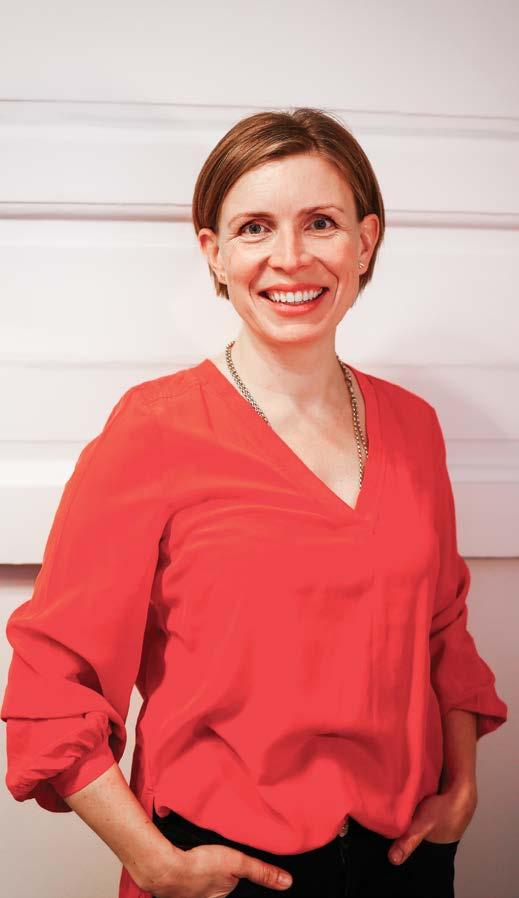
In a world increasingly conscious of sustainability, packaging remains a stubborn problem. Companies devote time and resources to designing recyclable packaging, yet beyond the consumer’s hand, a critical blind spot persists - what happens to packaging once it enters the recycling bin? Alice Rackley, CEO of Polytag, knows this gap well. “The hardest blind spot we set out to fix was the absence of data once packaging leaves the consumer’s hand. Companies invest heavily in recyclable design, but the moment it enters the recycling bin, all visibility is lost. It’s like shipping a package with no tracking; unthinkable in modern logistics.”
This absence of data is more than a simple oversight; it has become a serious regulatory challenge. As governments enact Extended Producer Responsibility (EPR) laws requiring businesses to prove their packaging has been recycled, companies face
mounting fines if they cannot demonstrate compliance. “This data gap is now a critical regulatory risk. With Extended Producer Responsibility (EPR) laws mandating that businesses prove they recycled their packaging, the lack of visibility means companies face massive fines for non-compliance.”
Polytag’s breakthrough comes from a surprisingly simple innovation with profound implications. The company applies invisible ultraviolet (UV) tags directly to packaging during production.
“Polytag cracked this by applying invisible UV tags to packaging during production. This allows us to track every item to its final destination in the recycling facility. We turn ‘recyclable’ into verifiable fact, providing businesses with the real-time, item-level data they need to meet their legal obligations.”
For an industry steeped in caution, introducing new technology is no easy task. Convincing major retailers and
waste processors to adopt innovations that impact their operations is a delicate balance. Yet, Polytag’s approach targets the acute pain points businesses face today. “We are solving very specific, very expensive problems that need to be tackled today. For retailers, our data becomes the audit trail for compliance required by EPR laws, turning a financial liability into a risk-mitigation strategy. It’s also a communication to savvy customers and stakeholders; demonstrating investment in the environment.”
For waste processors, the solution fits seamlessly into existing systems.
Crucially, the technology has proven its reliability in real-world settings. “For waste processors, our solution is non-disruptive; our Detection Units can be retrofitted into existing machine recycling facilities (MRFs), enhancing their infrastructure without costly overhauls. Critically, the technology works. Third-party tests, including achieving 100% detection accuracy with CITEO in a live MRF environment, show we’re the real deal.”
But where does regulation meet innovation? And how does Polytag navigate that sometimes turbulent space? “The collision point is scale, primarily seen in the limitation of Deposit Return Schemes (DRS). Legislators want high recycling rates, but
THE

traditional physical DRS is an infrastructure nightmare, requiring massive, costly overhauls of retail space and logistics. Consumers can’t or won’t take their recycling to a third location.”
DRS, which require consumers to return packaging to collection points in exchange for a refund, have faced criticism for their logistical complexity and limited consumer uptake. Polytag advocates a digital alternative — one that’s scalable and consumerfriendly. “Digital DRS (DDRS) is the only viable, scalable solution. We have run multiple pilots
proving that digital DRS works incredibly well, especially when including an incentive for the consumer.”
Standardisation is another crucial battleground. Without common data protocols, scaling innovations across borders becomes a technical and regulatory quagmire. Polytag built its systems on GS1 open standards, enabling global interoperability and collaboration with waste processors worldwide. “The second tension is data standards. We choose to build our systems on GS1 open standards to ensure global interoperability; the key to
cross-border scaling. We partner with waste processors across the globe to not just tag and trace recycling, but to enable smarter detection and sortation. This wouldn’t be possible without GS1 open standards.”
Behind Polytag’s cutting-edge tech lies an ethos of integration over disruption. This principle guides how the company builds solutions that operate harmoniously within the existing chaos of waste management infrastructure. “Integration beats disruption: our detection units work alongside existing }}
technology and often enhance the insight generated by sorting technology like near infra-red. Our data enables a feedback loop to businesses specifically about their packaging and products, allowing continuous improvement in design. We’re adding this crucial data layer without risky, expensive overhauls.”
Yet, creating technology that works isn’t just about software or hardware. It’s about engineering for real-world messiness, too. Bottles get crushed, labels torn, packaging covered in organic waste. These aren’t laboratory conditions, and Polytag has been rigorous in testing their solution against this relentless chaos. “We learned to build for chaos from day one. UV tags need to be readable when bottles are crushed, labels torn, packages covered in organic waste. That meant endless testing in actual MRFs with third parties checking our homework, not relying on sanitised lab conditions.”
So what if Polytag succeeds in scaling its technology globally? What will this mean for packaging, business responsibility, and consumer behaviour? Rackley foresees a fundamental shift in how packaging is valued. “Packaging stops being worthless waste and becomes a data asset throughout its lifecycle. Brands won’t just design for recyclabilitythey’ll design for verified circularity, because they’ll know exactly what happens to every package.”
Consumers, too, will feel the change, moving from guilt-ridden disposal to active participation in circular systems. By scanning codes, they’ll see tangible proof of their recycling’s impact - a visible loop instead of an invisible void. “For consumers, it changes packaging from guilt-driven disposal to informed participation. Scan a code, see your previous packages were recycled into new products. You’re part of a visible loop, not throwing things into an invisible void.”
Rackley’s vision through Polytag is a
step toward demystifying one of the most persistent problems in sustainability - what happens after the packaging leaves the consumer. By transforming packaging into tracked, verified data assets, Polytag offers companies a way to meet regulatory demands, reduce financial risk, and demonstrate genuine environmental responsibility.
In doing so, it also invites consumers to become informed participants in the circular economy - seeing their discarded packaging not as waste, but as part of a traceable, accountable lifecycle. The road ahead may be complex, and the waste management industry notoriously challenging, but the promise of technology that works with existing infrastructure and regulatory frameworks could be the breakthrough the sector has long awaited. As Polytag’s invisible tags quietly map the journey of every bottle and box, a new era of transparency and accountability in recycling may finally be within reach.
“FOR CONSUMERS, IT CHANGES PACKAGING FROM GUILT-DRIVEN DISPOSAL TO INFORMED PARTICIPATION. SCAN A CODE, SEE YOUR PREVIOUS PACKAGES WERE RECYCLED INTO NEW PRODUCTS. YOU’RE PART OF A VISIBLE LOOP, NOT THROWING THINGS INTO AN INVISIBLE VOID”


How leadership and culture drive innovation success. by
CRIS BESWICK
For two decades now, I’ve advised companies and governments worldwide on fostering innovation, and a troubling pattern remains consistent. Organisations invest heavily in innovation tools, labs, methodologies, and even new technologies –yet often fail to achieve breakthrough results or drive growth. But, in my experience, the problem isn’t usually a lack of knowledge, processes, or even the right tools. It’s something far more fundamental. And, it appears the facts don’t lie. A McKinsey study found that while 84% of executives believe innovation is vital for growth, a mere 6% are satisfied with their innovation outcomes. This gap highlights two often-overlooked factors crucial for innovation success: the actions of leaders and the underlying organisational culture.
Step into many organisations today, and you’ll see visible signs of innovation everywhere: design thinking workshops, dedicated innovation labs, ideation platforms, and lots of rhetoric around the word innovation. However, what’s often missing are the invisible ingredients that truly allow innovation to flourish – the daily decisions made by leaders, such as resource allocation, project prioritisation, and team management, the unspoken cultural norms, and the systemic conditions that either encourage or stifle the breakthrough thinking that innovation requires. This elaborate display, lacking genuine substance, is known as ‘innovation theatre.’ Think of it like a play with all the right props and costumes, but no real story or emotion. Despite its prevalence and the widely cited statistic that 70-80% of corporate innovation programs fall short of expectations, companies continue to invest
}}
resources in these visible components while neglecting the foundational leadership and cultural elements that dictate success or failure.
Here’s a critical point most leadership teams miss; innovation requires people to overcome millions of years of evolutionary programming because our brains are hardwired to feel potential losses about twice as intensely as equivalent gains – a phenomenon known as “loss aversion.” So, when organisations demand groundbreaking ideas but maintain systems that punish unsuccessful experiments, they are asking employees to override their biology without providing the necessary psychological safety to do so.
The Corporate Executive Board reported that 60% of employees have withheld innovative ideas specifically due to a fear of negative repercussions. This isn’t a communication issue or a process glitch; it’s a deeply rooted problem with leadership and culture. I’ve personally witnessed this dynamic unfold repeatedly in boardrooms around the world: executives demand innovation but reinforce governance systems that make it impossible to deliver. They champion “calculated risk-taking,” then penalise people whose experiments don’t yield immediate returns. They
claim to value learning from failure yet consistently promote individuals who never appear to stumble.
Building the capability for innovation demands a fundamentally different leadership approach than simply managing existing operations. Leaders must transition from a traditional ‘command-andcontrol’ style to one that emphasises coaching and enabling. They must demonstrate what I call ‘strategic vulnerability’ –acknowledging uncertainty, openly sharing their own mistakes, and modelling that not having all the answers is perfectly acceptable. It’s about being open and honest about the
challenges and uncertainties of innovation and showing that it’s okay not to have all the solutions all the time!
Neuroscience also confirms this: when leaders exhibit vulnerability, it can reduce team threat responses by 74%, creating an environment where creative thinking can thrive. Yet, most executives have spent their entire careers perfecting an image of certainty and control. Don’t get me wrong, it’s not actually the fault of most leaders. Leadership development and executive education haven’t been fit for purpose for decades. Meaning, what many leaders have been taught hasn’t set them up well for the cultures that they need to build and lead today.
Effectively leading for innovation involves several consistent behaviours:
} Resource Allocation: Leaders must dedicate meaningful resources to experimentation, even when immediate return on investment (ROI) is unclear.
} Curiosity Over Judgment: They must approach early-stage ideas with genuine curiosity rather than immediate criticism or judgment.
} Celebrating Learning: They must celebrate valuable failures as opportunities for learning, not just successful outcomes.
} Aligned Actions: Most critically, leaders must align their daily decisions with their stated innovation priorities. Employees judge an organisation’s

actual values not by what’s written on the walls, but by what leaders are willing to sacrifice to uphold them.
While leadership behaviours set the stage for innovation, culture determines whether these conditions truly take root and spread throughout an organisation. As the saying goes, culture isn’t what you say or what’s displayed on the office walls – it’s “what happens when no one is watching.” It’s the cumulative impact of daily decisions, interactions, and behaviours that define “how we do things around here.”
Building cultures that foster innovation requires leaders to address three crucial dimensions:
} The Psychological Dimension focuses on what safety means and how it’s created. It means cultivating environments where appropriate risk-taking is encouraged, and productive failures lead to insights rather than career consequences.
} The Physical Dimension encompasses practical aspects, such as dedicated time for exploration, easy access to customers and data, and the authority to act on promising ideas without excessive bureaucratic hurdles.
} The Mental Dimension addresses the necessary skills and capabilities, including design thinking, systems thinking, collaborative problem-solving, and the ability to navigate ambiguity. Unfortunately,
Organisations that successfully build innovationled cultures recognise that leadership and culture are not “soft” or secondary considerations. They are the primary determinants of whether innovation flourishes or fails” “
most organisations neither systematically develop nor consistently reward these critical capabilities.
In my humble opinion, one of the most underestimated forces in building innovation capability is middle management. They operate at the perfect intersection of strategic vision and day-to-day operations. They translate executive aspirations into practical actions, allocate resources to promising experiments, and create the essential psychological safety required for risk-taking within their teams. Furthermore, research indicates that organisations with strong middle management engagement in innovation are 38% more likely to succeed. When properly empowered, middle managers become the vital “drive layer” that transforms innovation rhetoric into genuine innovation capability.
The most significant mistake organisations make is treating innovation as a temporary activity or a program to be
implemented, rather than a fundamental capability to be built. Programs have defined start and end dates. Culture, conversely, emerges from thousands of daily decisions and interactions and is continuously evolving. Therefore, the right culture for innovation is cultivated through consistent leadership behaviours, aligned systems, and sustained commitment. Why is this important? Because building genuine innovation capability requires patience and persistence. It means making difficult choices about resource allocation, accepting that some investments won’t deliver immediate returns, and maintaining commitment even when short-term pressures mount.
For organisations serious about embedding innovation capability into their DNA, the starting point isn’t a new methodology or technology. It’s an honest self-assessment. Do your leaders consistently demonstrate the behaviours that genuinely enable innovation? Does your culture truly reward calculated risk-taking and
learning from failure? Organisations that successfully build innovation-led cultures recognise that leadership and culture are not “soft” or secondary considerations. They are the primary determinants of whether innovation flourishes or fails. They understand that sustainable innovation capability arises from the patient cultivation of organisational conditions where breakthrough thinking becomes both inevitable and repeatable. That isn’t innovation theatre. That is innovation leadership for the twenty-first century.

Cris Beswick has over 25 years of extensive experience as a CEO, serial entrepreneur, board adviser, and investor, Cris is now a globally recognised authority on innovation strategy, leadership and culture. The co-author of the bestselling management book ‘Building a Culture of Innovation’, he works directly with C-suite executives to create what he calls “the innovation equilibrium” - where strategy, leadership, and culture align to embed innovation into organisational DNA.
Adam Kamani’s game-changing property play. by
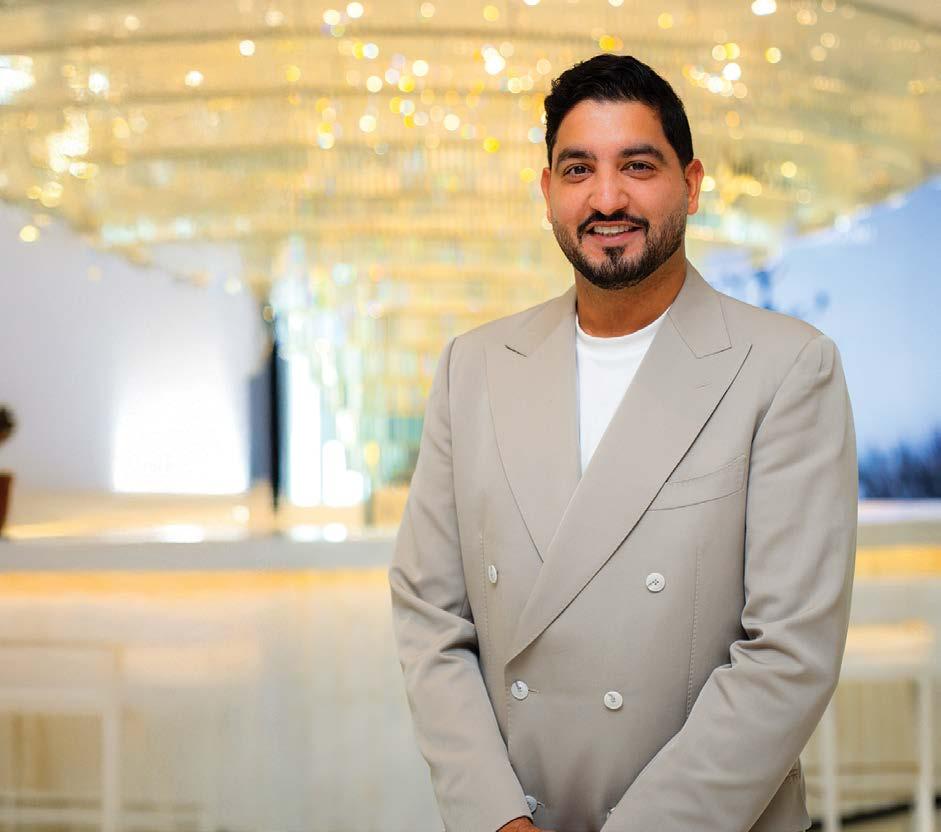

Entrepreneurship runs in Adam Kamani’s blood. Raised in a family where business was dinner table talk, Kamani has taken that legacy and made it his own. Now leading Kamani Property in Dubai, he’s redefining how real estate operates in a new market, fueled by lessons in self-belief, persistence, and innovation. In this exclusive interview with Entrepreneur UK, Kamani opens up about the personal challenges behind his rise and shares advice for anyone aiming to build their own path in business.
What inspired you to start your business?
I think growing up in a super entrepreneurial family definitely inspired me to try and be my own boss one day. It all started at home and my upbringing. It became second nature just to be talking about business at the dinner table.
What was your biggest challenge and how did you overcome it?
My biggest challenge has always been myself. I’m my own worst critic. I used to worry what everyone thought of me, how they perceived me etc. I put a certain level of expectation on myself and I realised I was trying to do what made others happy. Over time I questioned why I cared about other people’s judgement on me?! From that day on, I started acting in my own best interest and what was right for me and things started to change. My mindset changed. You have
to take care of yourself first. It starts to fall into place after that.
How did you secure your initial finding?
I’ve always had an interest in hotels and properties. So for me, naturally I was going to do that. I just had to figure out what made me stand out and better than the competition. You start learning and shaping your path along the way. No-one has it all figured out on day 1.
How do you handle failure or setbacks?
I used to let it eat away in my head. And don’t get me wrong, sometimes now when things haven’t gone the way I thought, it still bothers me. The truth is, if I’m
confident enough in my own ability then there’s no reason why I can’t overcome a setback. The motivation to go out and prove people wrong is enough for me to look at a failure and learn from it to be better next time.
What advice would you give to someone starting their own business?
Stay in your lane, be the best in knowledge, network with people, learn information. Listen to it, but don’t use it as gospel. Everything is constantly evolving so don’t be afraid to manoeuvre things. Lastly, don’t let other people’s opinions on you dictate how you do your own business.
How do you stay motivated during tough times?
For me, it’s my family. We recently moved to Dubai and that’s a big move in itself. Making sure my family is settled and happy is key to our next steps in our journey. I’m now heavily involved in Kamani Living which is redefining the way the real estate agency works out here. It’s given me a huge motivation to be a success and work smarter especially in a new country where I am starting over again. However, my past experiences in work will help me get there faster. I have full confidence in the business, the people around me and most of all myself.
The truth is, if I’m confident enough in my own ability then there’s no reason why I can’t overcome a setback. The motivation to go out and prove people wrong is enough for me to look at a failure and learn from it to be better next time” “

Ali Al Gebely’s blueprint for ONE Development by
PATRICIA CULLEN
→ Ali Al Gebely: Redefining real estate with ONE Development
The world of real estate has long been a competitive arena of bricks and mortar, with developers aiming to leave their mark in the form of glittering towers or sprawling urban landscapes. But in a rapidly evolving industry, Ali Al Gebely, the founder and chairman of ONE Development, a UAE based real estate company focused on creating intelligent, sustainable communities that blend technology, design and culture to shape the future of urban living, is trying something different. He isn’t just constructing buildings - he’s creating communities, environments, and, perhaps most notably, an entire way of life. ONE Development is not just about capitalising on market opportunities.It’s about building with intent - anticipating and responding to the evolving needs of future communities. When asked about his inspiration for entering the real estate sector, Al Gebely answers with a conviction that reflects his broader philosophy: “Our story begins with a simple purpose - to add value to everyday life.” This guiding principle is at the core of everything he does. His company’s }}
projects, spanning from the iconic Laguna Residence in Dubai to the DO New Cairo in Egypt, are infused with this sense of purpose. They aren’t just developments; they are meticulously crafted spaces
that respond to the changing needs of how we live, work, and connect. “Real estate, to me, is about understanding those needs and creating spaces that truly respond to them,” he says.
In an era where the boundaries between technology and daily life are increasingly blurred, Al Gebely is at the forefront of a new wave in real estate, where smart design and human needs come together to shape the cities of the future. At ONE Development, technology is not an afterthought - it’s woven into the very fabric of their designs. Whether it’s integrating AI to enhance daily living or incorporating wellness and sustainability into every building, Al Gebely believes in anticipating what people need before they even realise it themselves. “My leadership philosophy is built on transparency, structure, and agility,” says Al Gebely, explaining how he approaches both the management of his company and the real

estate projects it produces. Transparency means aligning his team with a shared vision; structure brings discipline and accountability; and agility enables the company to move quickly in a volatile market. This approach has led to ONE Development becoming a prominent name in a very short period of time. Al Gebely attributes his company’s rapid rise to the ‘clear vision’ driving every aspect of the business. His background with Al Gebely Holding, a family-owned business with over 40 years of industry experience, has provided him with a solid foundation of discipline, innovation, and long-term thinking.
Perhaps one of the most defining moments in Al Gebely’s career so far was the launch of DO Hotels, a ground-breaking hospitality concept that merges AI, music, and wellness into a unique offering. This development represents a new frontier in both real estate and hospitality. Al Gebely views it as more than just growth for his company; it’s a bold move to challenge industry norms. “A pivotal moment in my career was leading ONE Development’s regional expansion and launching DO Hotels, the world’s first themed hospitality brand that integrates AI, music, → Pioneering smart, sustainable cities for tomorrow


and wellness,” Al Gebely reflects. “It represented more than growth; it was proof of how speed and conviction can redefine industries.” In a world where digital transformation is fast becoming a necessity, Al Gebely’s ability to bring AI into the hospitality space shows just how adaptable the real estate sector can be. It’s a far cry from the traditional approach to hotel developments, instead focusing on integrating technology and lifestyle effortlessly. “It was inspiring to see how seamlessly creativity, technology, and lifestyle could coexist in real estate. That experience reaffirmed my belief that progress belongs to those who move first and move with purpose.”
For Al Gebely, real estate has a deeper purpose than mere financial gain. In a time when the business world is often critiqued for its pursuit of profits above all else, Al Gebely stands as an outlier. His focus is on creating lasting impact - both for the people who live and work in the spaces he develops, and for the broader urban environments in which those spaces are embedded. In an industry increasingly under pressure to embrace sustainability and responsible development, Al Gebely’s commitment to purpose-driven work is refreshing. “Purpose begins with impact,” he says. “It’s about contributing to something larger than your own organization while shaping progress that improves how people live, think, and connect.” At ONE Development, this purpose is translated into every project, from the AI-powered Laguna Residence in Dubai to the DO New Cairo project, which introduces ONE Development’s hospitality model into Egypt. Al Gebely’s vision is
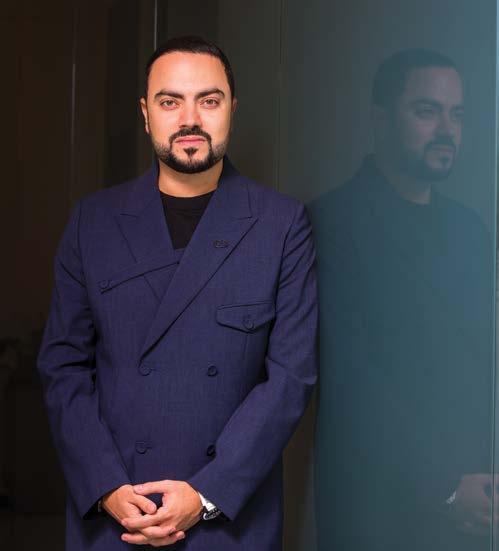
clear: it’s not just about creating physical structures but about fostering community and well-being - things that go far beyond the concrete and steel of typical construction.
Al Gebely sees sustainability as an inherent part of modern real estate. This isn’t just a passing trend, but an integral aspect of future developments. “We use modular construction to reduce waste, AI-driven systems to improve efficiency, and smart infrastructure to enhance daily living,” he explains. These are not buzzwords to him; these are tangible, strategic approaches that are changing the way real estate is developed, marketed, and lived in. This holistic view extends to how ONE Development’s projects are designed with long-term sustainability in mind. It’s not just about meeting today’s needs, but ensuring that these developments are resilient and relevant in the face of future challenges. Whether it’s integrating renewable energy into buildings or designing green spaces that promote well-being, sustainability isn’t an afterthought in ONE Development’s plans - it’s embedded in their DNA. But sustainability isn’t just about energy-efficient buildings; it’s also about creating people-centric spaces. The smart systems built into Laguna Residence, for instance, are designed not only to conserve energy but to improve the quality of
“PURPOSE BEGINS WITH IMPACT. IT’S ABOUT CONTRIBUTING TO SOMETHING LARGER THAN YOUR OWN ORGANIZATION WHILE SHAPING PROGRESS THAT IMPROVES HOW PEOPLE LIVE, THINK, AND CONNECT”
life for residents. Whether it’s through controlling temperature, lighting, or even the use of shared community spaces, Al Gebely’s approach ensures that technology is always working toward improving human experience. “Every element, from its AI-enabled infrastructure to its sustainable design approach, reflects our commitment to anticipating how people want to live - not just today, but in the years ahead,” he adds.
While many developers focus on profits, Al Gebely sees real estate as a powerful tool to build strong communities. In his eyes, the most successful developments are those that not only offer a place to live but actively contribute to the social fabric of a city or region.
“Whether in business, design, or leadership, purpose means leaving things better than you found them and ensuring that growth benefits more than just the bottom line,” he explains. “In real estate, that translates into creating environments that move people forward. It is not only about building structures but designing spaces that

IT WAS INSPIRING TO SEE HOW SEAMLESSLY CREATIVITY, TECHNOLOGY, AND LIFESTYLE COULD COEXIST IN REAL ESTATE. THAT EXPERIENCE REAFFIRMED MY BELIEF THAT PROGRESS BELONGS TO THOSE WHO MOVE FIRST AND MOVE WITH PURPOSE”
foster culture, connection, and sustainability. Every project should create lasting value by improving quality of life and setting new standards for how cities evolve.” In a sense, ONE Development is more than just a real estate firm. It’s a social innovator. By focusing on creating intelligent, integrated communities, Al Gebely is laying the foundation for a new kind of urban living - one where residents are connected not only by shared space but also by shared values.
Looking forward, Al Gebely has grand ambitions for ONE Development. In the next five years, he envisions the company becoming a global player, with a significant presence in markets across the Middle East, Europe, and beyond. “London, China, and Saudi Arabia represent the next frontiers of opportunity,” he notes. “We are focused on building an international brand that carries regional values and translates them into developments that resonate on a global stage.” Al Gebely’s strategy is grounded in understanding local cultures and socioeconomic needs while adapting these insights to global markets. His eye on markets like Egypt and Saudi Arabia speaks to his broader understanding of urban transfor-
mation and his belief that real estate development can be a key driver of social change. As for the wider implications of his work, Al Gebely isn’t just aiming to create individual successes but to set a precedent for the real estate industry. By integrating AI, sustainability, and community-driven design, he is shaping a model for the future - one where developments are not just financially profitable but socially and environmentally responsible.
Al Gebely’s advice to aspiring developers is rooted in purpose, not prestige. “Stay driven by impact, not position,” he says. “Move with speed, think with clarity, and never lose sight of the bigger picture.” For him, success isn’t about titles or accolades, but about creating meaningful change and shaping the future of cities. As his company continues to expand, this mindset - prioritising vision, impact, and strategy - serves as a blueprint for the next generation of developers who will redefine real estate. “Real estate is not only about building structures but about shaping life itself,” he asserts. Those who grasp this philosophy, he believes, will lead the future of urban development.


Why solo-founder unicorns may not be worth chasing by YASIN
ALTAF
Ever since Sam Altman floated the prediction that we could see the rise of the one-person tech unicorn, the start-up world has been fixated on the idea. Investors and founders alike are asking: what happens if a single person, armed with AI tools, can build a billion-dollar company? On the surface, the numbers make this vision seem plausible. Lovable, the Swedish start-up, reached a $1.8bn valuation with a team of just 35. The pace of AI innovation is so fast that we could see unicorns built by teams of fewer than 10 in the very near future. Some speculate that within the next year, a single founder and their AI “co-pilots” could be enough to cross the billion-dollar line. But should this be celebrated? Beyond the headlines and hype, we need to ask:
what is the actual value of a unicorn with just one founder and one employee?
Why one-person unicorns ring alarm bells
First, one-person unicorns are unlikely to produce great products and code. Innovation happens through collaboration, iteration, and healthy debate. A solo founder leaning too heavily on AI tools may generate products that look polished at first glance but lack depth, robustness, and scalability. Without diverse human perspectives, these products risk being brittle - shiny prototypes that cannot withstand the test of time or the complexity of global markets.
Second, one-person unicorns are not going to produce great
companies. A business is more than its product. It is about culture, leadership, and the ability to inspire people to rally behind a mission. A founder with no team cannot build resilience, succession planning, or trust with investors, partners, or customers. To deliver world-class products and services, you need people with different mindsets - people who challenge assumptions, question strategy, and bring in fresh perspectives. Companies are living organisms, not
raising capital or booking revenue, but by employing people, paying taxes, and strengthening supply chains. A unicorn with one employee does almost nothing for job creation, regional growth, or community development. Over the past decade, governments have supported tech with favourable policies precisely because it drives employment and prosperity. If AI-enabled unicorns cut humans out of the equation, policymakers will be right to ask: what’s the point?
But we cannot confuse lean teams with no teams. Even Lovable, after hitting unicorn status, has begun hiring aggressively across departments. The reality is that great companies eventually need great teams. The myth of the one-person unicorn risks distracting us from this truth. It may play well on social media, but it is not a sustainable model for building enduring businesses or resilient economies. Instead of fetishising the solo founder with an AI stack, we should be asking how
CAPITAL EFFICIENCY SHOULD ABSOLUTELY BE CELEBRATED. FOUNDERS WHO CAN ACHIEVE MORE WITH LESS DESERVE RECOGNITION, ESPECIALLY IN TODAY’S FUNDING CLIMATE. BUT WE CANNOT CONFUSE LEAN TEAMS WITH NO TEAMS”

codebases, and they require more than one brain to grow.
Third, one-person unicorns won’t help the economy or local ecosystems. Start-ups create value not just by
Capital efficiency isn’t everything
Capital efficiency should absolutely be celebrated. Founders who can achieve more with less deserve recognition, especially in today’s funding climate.
AI can empower human teams to go further, faster.
What we should be building instead
The real opportunity is the rise of the AIaugmented team. This is not about replacing people, but about equipping small, talented groups with AI tools that amplify their productivity and creativity. Imagine a five-person startup that can move at the speed of a fifty-person team. Or a ten-person scale-up that can serve millions of users worldwide without ballooning costs. These are the kinds of companies that will shape the future. They will still build cultures, create jobs, and contribute to local ecosystems, but they will
also be leaner and faster than their predecessors. They will use AI not as a crutch, but as an accelerator. And they will be the ones to produce products that are both innovative and sustainable.
A more human vision of the AI future AI will change the startup landscape forever. It will lower barriers to entry, reduce costs, and help founders get from zero to one faster than ever before. But the goal should not be to eliminate people from the equation entirely. The goal should be to create better companies, companies that are agile, resilient and capable of delivering long-term value. Rather than chasing the dream of the one-person unicorn, we should celebrate the teams that are using AI to build smarter, stronger, more impactful businesses. These are the companies that will truly move industries forward. Leaner, faster, yes. But still fundamentally human

Yasin Altaf is the co-founder of GoodCore Software, a software consultancy working with start-ups through to global corporates. GoodCore Software is co-headquartered between London and Karachi. Yasin started his career in Silicon Valley and has been a software developer for more than 20 years.
Struggling to start a business alone? There is another wayfranchising. Many people choose the franchise route because it’s usually faster, less risky, and less lonely than setting up independently. by
PIP WILKINS
What is a franchise?
A franchise is a business built on a pre-determined model, created by a company (called the franchisor), which is seeking to grow. The franchisor provides you, the franchisee, with its business name, methods, experience and support, in exchange for an investment, which can vary from under £10,000 to a six-figure sum.
Your business belongs to you, but you agree to follow the franchisor’s business model and pay a monthly fee to the franchisor. Neil Martin, Director of Marketing and Edutainment, at business coaching firm ActionCOACH UK, explains:
“Starting a business is like baking a cake. You can experiment, guessing
ingredients and hoping it turns out right, all whilst juggling everything at once, from building the brand to finding customers. Independent founders can feel isolated, with no one to turn to when things get tough. Because the business is new, they must fight hard to earn customer trust.”
However, with a franchise, he says: “You follow a proven

recipe, tested many times. A franchise provides the right ingredients, clear instructions, and expert guidance. You still have to bake the cake, but a good franchise removes much of the guesswork. With a proven system, support, and a trusted name behind you, you can spend more time growing the business.”
The secret’s in the model
The secret of franchising’s success is the business model. Martin says: “From day one, you’ve got training, systems, brand recognition, and a support network that removes much of the chaos most start-ups face.” With an established franchise you can see its history, no guesswork is required. Franchising is also a co-operative model: the franchisor makes money if you, the franchisee, make money, so the franchisor is motivated to support your business success.
There are around 320 BFA-accredited franchises. Since 1977, the BFA has championed ethical business practices and high standards. Our online directory is a great place to start, you can filter opportunities by sector, investment level and lifestyle fit.
Why franchising is doing well
Despite an uncertain overall business climate, franchising is thriving. According to the latest data from the British
Franchise Journal 2024, compiled for the BFA and sponsored by NIC Local, the total number of franchise systems has reached a record high of 1,009, an 8% increase since 2018. The total number of franchise units rose to 50,421 (a 4% increase) over the same period and the personal services sector saw a huge surge, with a 53% increase in new systems. Franchising has had a less than 6% failure rate for over 20 years. Barclays, one of several franchise lenders, says that currently, 89% of all franchise units are profitable, with an average turnover of more than £400,000 per unit.
A franchise provides the right ingredients, clear instructions, and expert guidance. You still have to bake the cake, but a good franchise removes much of the guesswork”
Changing sectors successfully
The franchise model also allows you to change career into a new sector, because it provides training. It can provide a way to use existing skills gained as an employee, to set up your own business.
The cat butler
Sandra James set up The Cat Butler franchise in 2015, when she was unable to find the right standard of
WITH RECORD GROWTH, STRONG SUCCESS RATES AND THE FLEXIBILITY TO CHANGE CAREERS OR SECTORS, FRANCHISING HAS NEVER BEEN A MORE POWERFUL ROUTE INTO BUSINESS OWNERSHIP”

care for her own cat.Sandra says: “The franchise model is brilliant for people with the passion but perhaps not the business experience to set up a new venture. Our franchisees want to build a career around caring for cats and the support structure makes all the difference.” Franchisees get full training before their launch, in cat care and first aid, but also in marketing, customer service, operations, finance, and compliance. “Once they’re up and running,
we stay closely involved with ongoing mentoring, regular check-ins, group meetings, and a library of resources. Franchisees never feel alone – they can share experiences, tips, and encouragement with other franchisees,” says James. “By combining their love for animals with solid business foundations, franchisees can focus on delivering excellent care to cats and reassurance to owners, while knowing that they’ve got a proven system, brand reputation, and continuous support. That’s why the model works so well – it allows people to follow their hearts while building a sustainable and profitable business.” With record growth, strong success rates and the flexibility to change careers or sectors, franchising has never been a more powerful route into business ownership. Before you make any big decisions about starting a business, explore the world of franchising. You’ll still be your own boss, but with a trusted brand, a proven system and expert support on your side. Visit www.thebfa.org to explore accredited franchise opportunities and ‘Discover your tomorrow’ today.

Pip Wilkins is the Chief Executive of the British Franchise Association (BFA), bringing over 25 years of dedicated experience in the franchising sector. Having progressed through various roles within the BFA, Pip has gained a comprehensive understanding of the broader franchise industry, earning widespread respect for her deep expertise and unwavering commitment. She lives in Devon and is an avid Chelsea FC fan
As Partner and Head of the First Cheque Fund, the dedicated pre-seed fund at Octopus Ventures, Kirsten Connell backs bold founders at their earliest - and often riskiest - stage. Here’s what she looks for, what she advises, and why the first “yes” matters most.
PATRICIA CULLEN
Before the traction, before the pitch decks are polished, before anyone else believes - Connell does. She is often the first institutional investor to back an idea. She specialises in helping ambitious entrepreneurs get their companies off the ground with the capital, conviction, and clarity they need to go the distance. Entrepreneur UK sat down with Connell to unpack what makes a standout early-stage founder, how to handle a “no,” and the start-up trends she’s watching closely.

What are the top three things founders should focus on when preparing to raise their first round of funding?
1/Nail your “why now, why us.”
Investors want to see a simple, must-have problem and your unique edge in solving it: whether that’s a powerful insight into the space, access to unique data, or an execution advantage that sets you apart.
2/Show you can execute. Early-stage investing is all about belief in the team. Demonstrate that you’re a “complete finisher”: follow up fast, build a smart hiring plan, gather credible references, and lay out an actionable go-to-market path.
3/Leverage your network and distribution edge. Great founders make unfair advantages visible. Whether through partnerships, customer access, or community momentum, show that you
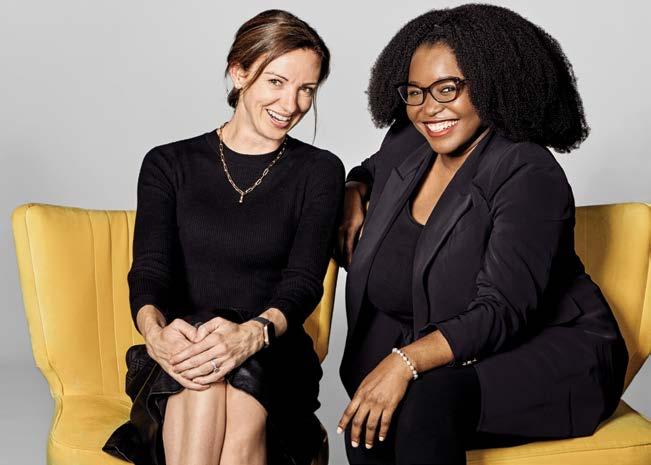
Early-stage investing is all about belief in the team. Demonstrate that you’re a “complete finisher”: follow up fast, build a smart hiring plan, gather credible references, and lay out an actionable goto-market path” “
know how to use your network to accelerate traction.
When evaluating earlystage start-ups, what key factors do you prioritise?
1/Founders, above all. We back mission-led, learning-agile, and reliable founders who can sell to their customers and attract top talent. We have to believe you’ll build a venture-scale business.
2/A market that matters. We look for markets that can grow into something big enough for venture returns, and a clear path to
defensibility - through data, product embedment, model performance, or distribution.
3/Early proof points. Signals that you’re on the right track: credible design partners, an actionable pipeline, or early commercial traction - all help us believe you’ll hit your next funding milestones.
How should founders handle a “no” from an investor?
A “no” isn’t the end of the story - it’s just one investor’s thesis or timing. Take what’s
useful from their feedback and move on quickly. Many breakout companies were passed on early. If you’ve built a genuine connection, keep that relationship warm. Share key updates, ask for input, and invite them to be part of your journey - even informally. The best investors will keep cheering you on, whether they’re on your cap table yet or not.
What start-up sectors or trends excite you most right now?
We’re excited by founders applying advanced technology - especially AI
- to big, unglamorous problems. Think supply chains, logistics, water, or waste: the real, gritty systems that power the world. We’re also seeing inference costs fall by nearly 90% over the last 18 months, unlocking use cases that were previously uneconomical - like real-time AI video or large-scale customer service. And with around 70% of enterprises saying proprietary data is their biggest blocker, startups that help businesses structure or monetise their unique data are set to win.
Which Octopus Ventures portfolio companies have you been most excited about this year?
} Gibran
Gibran is pioneering a new class of AI - Scale-Free Learning AI (SLAI)inspired by the “Major Transitions” concept in evolutionary biology. SLAI could deliver step-change efficiency gains, genuine reasoning, and even new knowledge creation. We love their bold, science-first approach to next-generation AI.
} Flux
Flux is reimagining the hardware foundation of AI. By designing optical processors for training and inference, they’re building the infrastructure that could power the next leap in general intelligence.
} Visible Visible is a wearable platform built for illness, not fitness - empowering people to manage chronic health conditions rather than count steps.
The entrepreneur fueling a new wave of founders
Jack Whettingsteel’s journey from supermarket night shifts to co-founding HelpBnk, a community-powered platform that’s redefining how entrepreneurs access mentorship, with Simon Squibb, is a striking reminder that the path to entrepreneurship doesn’t have to be conventional. Whettingsteel’s entrepreneurial journey didn’t begin in a boardroom or business school - it started in a Sainsbury’s during lockdown, with nothing but curiosity, TikTok, and a desire to break free from the system. In this exclusive Entrepreneur UK interview, Whettingsteel reflects on investing his mum’s £3,000 life savings in a marketing course, pitching Richard Branson on a flight to New York, and launching the Doorbell of Dreams to bring bold ideas to life.
→ Jack Whettingsteel, co-founder of HelpBnk
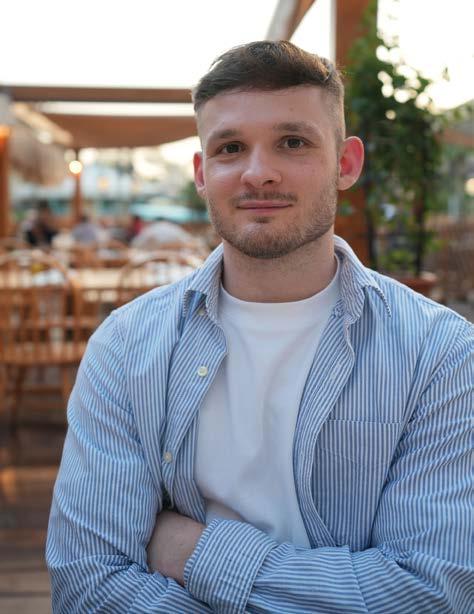
You’ve had an unconventional entrepreneurial journey. Can you take us back to the beginning and share what first sparked your passion for helping entrepreneurs? I’ve always had an intense drive to do something meaningful, but growing up, I wasn’t sure what that meant. As a kid, I said I wanted to be an inventor because it seemed cool, but the education system didn’t see that as a ‘real job’, so I quickly abandoned that dream. Throughout school, I had a real anger at the path it seemed to be pushing me down and the things it was making me do. The system felt limiting - it pushed me down a predetermined route that didn’t align with who I was or what I felt capable of achieving. It wasn’t
until I was 19, during lockdown, whilst working at Sainsbury’s as an assistant manager, that everything changed. I had more time, like everyone did, and suddenly TikTok’s algorithm started showing me content around self-development. I began learning things school never taught me - how finances actually worked, what mortgages were, basic life skills that should have been fundamental education. The algorithm, which seemed to know me better than I knew myself, started serving up entrepreneurship content. I started seeing people making an entire yearly salary in a single month online, and I was absolutely hooked. For the first time in my life, after feeling somewhat confused about
I BECAME OBSESSED WITH THE IDEA OF ENTREPRENEURSHIPNOT JUST FOR THE MONEY, BUT FOR THE FREEDOM AND POSSIBILITY IT REPRESENTED. THAT WAKE-UP MOMENT CHANGED EVERYTHING”
what the right path was for me, everything suddenly made sense. I became obsessed with the idea of entrepreneurship - not just for the money, but for the freedom and possibility it represented. That wake-up moment changed everything. Ever since, I’ve been motivated to help others have that same realisation - that life can be so much more than what the system tells you it should be. I wanted to help people have the same spark I did, to help them believe in themselves and take control of their own destiny. So many young people, or people of any age really, simply don’t realise what’s possible because they’ve never been shown an alternative path.
Interestingly, as soon as I started making even a small amount of money, I found I wasn’t as motivated by money as I thought I would be. What really drove me was the idea of helping other people take control of their lives. This multiplied exponentially when I met Simon Squibb four years ago. He was homeless at 15 and built his entire platform specifically to give back to his younger self. Seeing how deeply he cared about the purpose, how much it motivated him despite the money he’d already made, was absolutely infectious. Since meeting Simon, this mission has been front of mind with everything we’ve built. It’s not just about business success anymore - it’s about creating a platform that can genuinely change lives and show people what’s possible when they take control of their own future.
You invested your mum’s £3,000 savings in a marketing course. What’s the most important lesson that taught you about risk and investment?
The key difference wasn’t the amount - I’ve spent £3,000 on many things since then with my own money and it didn’t have the same effect. When it was my mum’s savings, the pain of letting her down was greater than any pain required to build my business. I refused any option other than

succeeding because I couldn’t waste money she’d saved for me. That £3,000 represented years of my mum putting aside £20 here, £50 there - small amounts that added up over time through genuine sacrifice. When she handed it to me and said “spend it however you like,” I felt the weight of every pound she’d saved. It wasn’t just money anymore - it was her faith in me made tangible.
The pressure was immense. Every sales call I took for the company I was starting, every rejection I faced, I could feel that responsibility. I took 30+ sales calls before landing my first client, and each “no” stung because it wasn’t just my failure - it was potentially wasting her sacrifice. But that pressure became my greatest asset. When you’re using someone else’s belief in you as fuel, giving up simply isn’t an option. It taught me that taking risks creates the motivation to succeed, but it’s less about the money itself and more about how much it really means to you and the consequences of failure. The best investments aren’t just financialthey’re emotional. When someone puts their faith in you, especially someone who’s made real sacrifices to do so, you’ll move mountains to prove them right.
The Doorbell of Dreams is a unique and creative initiative. Can you tell us more about it and how it came to life as part of your mission to empower entrepreneurs? It started when Simon Squibb bought a staircase in Twickenham that was up for sale and in the news. His idea was to turn it into a symbol of hope - showing how success is step by step, maybe even an entrepreneur hub. Our head of production, Dudley Dodd, had the idea to put a Ring doorbell on it so people could pitch their ideas. Working alongside our creative co-founder Callum Church, we’ve
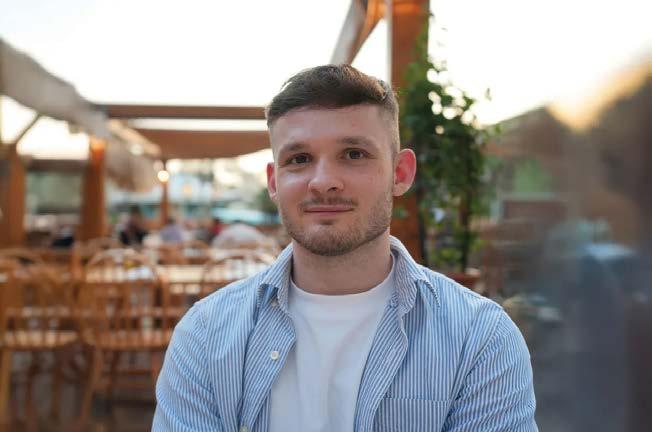
since been able to turn these simple doorbell pitches into compelling content that’s helped people find mentors, funding, and co-founders.
What makes this so powerful is the contrast with traditional platforms. Unlike Shark Tank or Dragons’ Den where only a few people can get in and give up huge equity, anyone can pitch to our doorbell and the best ones are shared with millions online. There’s no gatekeeping, no barriersand anyone can pitch. You never know what connections or opportunities might emerge from that exposure.
We took the concept to the next level when I pitched Richard Branson on his plane. I’d been waiting in the flight bar for the right moment, and when I finally got my chance, he mentioned he’d
always wanted people to pitch ideas in his hotel lifts. So I suggested we put doorbells there. To my surprise, he loved it, gave me his email, and after following up a few days later, he replied and looped me in with his amazing team.
Since then, we’ve installed doorbells in Virgin Hotels in London and New York. Now people in either city can walk up to the lift and pitch their idea directly. Thousands have done exactly that, and the content has been seen by millions across our platforms. It’s given entrepreneurs from all backgrounds the chance to get their ideas in front of a global audience.
HelpBnk has really leveraged social media to change the mentorship landscape. How is the
platform using digital tools to revolutionise mentorship for today’s entrepreneurs?
The beauty of social media today is that it allows you to get in front of the whole world, get your business or idea in front of millions of people just by recording content or writing content and uploading it online.
At HelpBnk, we encourage entrepreneurs to leverage this by creating their own content or by pitching to our doorbells, which we can then use to create content to promote their businesses and get them the exposure they need.
But beyond that, the beauty of today’s technology is that you don’t necessarily need to find one individual mentor to help you grow your business anymore. The traditional mentorship model was quite limiting
- you’d have to find someone successful, convince them to give you their time, work around their schedule, and hope they had experience relevant to your specific situation. Now, you can access a like-minded community on a platform like HelpBnk where thousands of entrepreneurs are sharing knowledge, experiences, and advice in real-time. We’ve also built tools like our “My Journey” feature, where you can simply explain a bit about yourself and what your business idea is, and it will give you a completely personalised process and guide to grow your business, acting like your own digital mentor that’s available 24/7. It’s not replacing human connection, but it’s giving people immediate access to guidance when they need it most. What’s exciting for us is really leveraging the power of community that we can build through creating social media content that people align with and engage with, whilst simultaneously using AI and today’s digital tools to create technology that genuinely helps people get the specific help they need to grow their business.
HelpBnk’s CEO Adam Moss has been brilliant at leading the team and setting the product vision that’s made tools like ‘My Journey’ possible, working closely with our CTO Yordi De Klein to turn these ideas into realitydriving the strategy of how
we can use technology to democratise mentorship and make it accessible to entrepreneurs worldwide. The combination of community-driven support and AI-powered guidance means entrepreneurs can get help at any stage of their journey, whether they’re just starting out with an idea or scaling an existing business. It’s mentorship that scales, mentorship that’s always available, and mentorship that evolves with your specific needs.
Reciprocal mentorship is at the heart of HelpBnk. How do you balance the act of giving and receiving mentorship in a way that drives long-term success?
The interesting thing is that as much as people need help and ask for help on a platform like HelpBnk, there are also many, many other entrepreneurs who are succeeding or have succeeded or have been helped by someone who wants to give back. We believe that humans are inherently good, and we’ve seen that entrepreneurs typically really want to help each other - they just need a convenient way to do so that works on their time schedule. What we’ve discovered is that everyone has something to teach and something to learn, regardless of where they are in their journey. A seasoned entrepreneur might know about scaling and fundraising, but a 22-year-old might know things about TikTok marketing or Gen Z consumer behaviour that the experienced entrepreneur has never encountered.
So reciprocal mentorship works because it removes the traditional hierarchy that makes mentorship feel awkward or transactional.
Our head of community, Adam Smith, has found that the balance happens naturally when you create the right environment for both giving and receiving. On HelpBnk, someone might ask for help with their pitch deck in the morning and then spend their lunch break helping someone else with their social media strategy. It’s not a formal system where you have to “pay it forward” - it’s just that when you make it easy and convenient for people to help each other, they naturally do.
We’ve also found that giving help is often as valuable as receiving it. When you help someone solve a problem, you’re reinforcing your own knowledge, seeing challenges from a fresh perspective, and often learning something new in the process. That’s why we built HelpBnk to make it equally easy to ask for help and give help back. The platform is designed so that you can contribute when you have five minutes or when you have an hour, fitting around your existing commitments rather than requiring a formal mentoring relationship with set meetings and obligations.
Looking ahead, what’s the one crucial skill entrepreneurs must develop in the coming years to stay competitive in an increasingly tech-driven world? Purpose. The biggest thing I’ve learned from Simon Squibb. It might
We took the concept to the next level when I pitched Richard Branson on his plane. I’d been waiting in the flight bar for the right moment, and when I finally got my chance, he mentioned he’d always wanted people to pitch ideas in his hotel lifts”
sound cheesy, but I genuinely think it’s the most important thing. AI makes it easier than ever to build a business - you can create websites, write copy, design logos, and even build basic apps without needing technical skills. It’s also easier than ever to market your business if you understand social media and digital tools.
So when the barriers to entry are lower than they’ve ever been, and when AI can help anyone create a technically competent business, what’s going to make you stand out? What’s going to make you last when the market becomes saturated with AI-generated businesses and cookie-cutter startups?
It’s having an authentic purpose to your business that really matters to you. Not a purpose you’ve created because it sounds good in investor pitches, but something that genuinely drives you. Something that’s going to keep you going when you face inevitable setbacks, when competitors emerge, when the market shifts, or when you’re dealing with difficult customers or regulatory challenges.
Purpose is what gets you out of bed every day to ensure your business succeeds, no matter what obstacles arise. When you have a real mission behind what you’re building, you’ll outwork, outlast, and outthink competitors who are just chasing money or following trends. You’ll make better decisions because you have a clear north star, you’ll attract better team members who share that vision, and you’ll build deeper connections with customers who believe in what you’re doing.
In a world where anyone can build a technically solid business, the differentiator becomes why you’re building it and how much you truly care about solving the problem you’ve identified. That authentic drive is something AI can’t replicate and competitors can’t easily copy.
How to /

The dream of many founders is to grow fast, make headlines, and become the next unicorn. But in the rush to scale, some start-ups fall into a dangerous trap: believing they’re untouchable. When founders - and their teams - start thinking they can do no wrong, they risk creating a culture of hubris. This can sink the business before it reaches its potential.
Ahubristic culture means that employees become convinced that they should do whatever it takes to achieve the start-up’s grand ambitions. This mindset makes employees believe that the end goal of start-up success justifies using any means. This can involve threatening the company’s critics, spying on regulators, or releasing products quickly before verifying that they are not harmful for customers. These actions might help the start-up briefly in the short-term. However, they create major trouble for the company and for society in the long-run.
We’ve all seen the headlines: start-ups that soared on hype only to crash amid scandal. A hubristic culture may feel like high-energy hustle on the surface, but beneath it often lies recklessness, denial of criticism, and a disregard for key stakeholders.
The Cost of Hubris
There are many cautionary tales of how a culture of hubris can grow unchecked in high-pressure start-up environments. Together with my colleague, Dr Elena Dalpiaz, I studied how the problem of hubristic culture arises and how to solve it in a fintech start-up. The company had to completely reform its operations and culture to address its problematic hubris. This was important because it was leading the company to pursue growth at all costs and harm customers. This was undermining its future. The writing was on the wall. Founders can avoid this fate for their start-up by looking out for warning signs and taking decisive action.
How to spot a hubristic culture
Hubris doesn’t announce itself with flashing lights. But there are early warning signs every founder should watch out for:
} Pursuing growth at all costs
If your team starts chasing growth with no regard for customers, regulators, or the public, you are veering into dangerous territory. This often shows up as neglected customer service, negative media attention, or regulatory scrutiny.
This will catch up with you, even if you may be able to sustain fast growth for a while longer.
} Defaulting to dismissing criticism
Does your founder team routinely wave off concernswhether from employees, customers, or the press?
Ignoring feedback or even attacking critics can be a red flag. Some leaders rationalize this by claiming outsiders “don’t get” the company’s vision or are biased to favour incumbents. Ask yourself if your company has become an echo chamber that is not longer able to take stakeholder feedback on board?
} Generating the wrong kind of excitement
If your team gets excited about breaking rules and about getting criticised by the outside world, your company has fallen prey to “antagonistic excitement”. Employees are motivated for the wrong reasons and dangerously ignore the needs of stakeholders. For example, watch out when employees get excited about getting criticised for launching products that are untested or for ignoring regulatory requirements. In one startup we studied, an employee admitted, “We were getting attacked (by protestors) … You live off that adrenaline.”
How to prevent hubris
The good news is that hubristic cultures aren’t inevitable in entrepreneurial companies. Here are three steps founders can take to safeguard their ventures:
} Focus on sustainable growth
Chasing growth at all costs stores up long-term trouble. It’s
important to focus on growth that is sustainable for customers, rather than on growth that harms them. The fintech we studied made a conscious shift from chasing short-term wins at all costs to helping customers navigate financial challenges responsibly. As a result, the default rate on its consumer loans halved over three years. Growth is healthiest when it aligns with long-term value for customers and society.
} Build a transparent culture It’s dangerous when companies become echo chambers that automatically dismiss any external criticism, rather than learning from it. Open dialogue matters to understand what the company is doing and how stakeholders are reacting to it. It’s important that employees are encouraged to bring problems to leaders so that they can be resolved quickly. The alternative is that these problems are hidden until they spiral out of control. Consider introducing regular town halls to acknowledge mistakes and discuss how to fix them and learn from them. The fintech company that we studied adopted this approach. This transparency paid off: The fintech stopped getting regulatory fines, in a stark reversal from its fine-riddled early years.
} Channel excitement in the right way
It’s great for teams to feel passionate about the mission. But founders need to steer that excitement toward creating a positive impact for what the venture is building, rather than focusing employees on excitement about breaking rules or creating controversy for its own sake. For example,
IF YOUR TEAM STARTS CHASING GROWTH WITH NO REGARD FOR CUSTOMERS, REGULATORS, OR THE PUBLIC, YOU ARE VEERING INTO DANGEROUS TERRITORY. THIS OFTEN SHOWS UP AS NEGLECTED CUSTOMER SERVICE, NEGATIVE MEDIA ATTENTION, OR REGULATORY SCRUTINY” “

are you generating excitement by telling employees to “fight the establishment”? Consider refocusing that excitement on delivering on the company’s purpose and what it makes it unique. At the fintech we studied, such a shift bore fruit: After the change, 70% of employees stated on Glassdoor that they would recommend the company to a friend. The fintech had successfully transitioned from a hubristic culture with its accompanying toxic behavior to a purposedriven approach that sets the company up for long-term success.
The bottom line
A culture of hubris can derail even the most promising ventures. It’s important that companies recognise and address hubris before it’s too late. By watching out for the warning signs and fixing issues early, founders can build ventures that will go the distance, rather than crash and burn prematurely.

Dr Christian Hampel is Associate Professor of Entrepreneurship & Social Innovation at Imperial Business School.
Lesley Sackey’s journey from Team GB boxer to tech visionary
by PATRICIA CULLEN
When Lesley Sackey steps into a room, she carries with her the quiet confidence of someone who’s already been knocked down and got back up. Not once, but over and over - first in the boxing ring, and now in the brutal arena of tech entrepreneurship. “Boxing taught me discipline, resilience, and how to get back up after being knocked down,” she says. “Those are all qualities you need as a founder.”
For Sackey, the transition from athlete to entrepreneur wasn’t a sharp pivot - it was a natural extension of purpose. After representing Great Britain in boxing, she found herself asking a different kind of question: what now? “When I retired, I realised what I’d loved most wasn’t just competing, it was helping others find strength through struggle,” she reflects. “Pillow came from that same instinct to build something that could help women rebuild their


“
I WANT TO PROVE THAT IMPACT AND SCALE CAN COEXIST, AND THAT PURPOSE-DRIVEN COMPANIES CAN GROW FAST AND CHANGE LIVES. MY HOPE IS THAT PILLOW BECOMES THE FIRST SOCIAL UNICORN, NOT JUST BY VALUATION BUT BY HOW MANY PEOPLE IT UPLIFTS”
lives after crisis, but at scale.”
That drive led to the creation of Pillow, an AI-powered platform for survivors of domestic abuse. It’s a solution born not from abstract brainstorming, but from deep, lived experience - and Sackey is unapologetically clear about that. “Pillow was born from both lived and learned experience. I’ve seen how hard it can be to rebuild when systems feel cold and disconnected. I wanted to create a trauma-informed platform that offers warmth, choice, and community, where
women don’t just survive, they thrive.” In a tech world often enamoured by disruption for disruption’s sake, Sackey brings a refreshing clarity to what innovation should actually achieve: power redistribution. “It is about using tech to give back power, not take it away.”
But stepping from the comfort of the ring into the coded corridors of tech came with its own fight. “Tech can still feel like walking into a boxing gym full of men. You have to prove you deserve to be there,” Sackey says. She’s candid about the hurdles, not just personal, but systemic.
“The biggest challenge is learning the language of tech without losing the language of purpose. You quickly realise imposter syndrome doesn’t mean you are not capable, it means you are in a room that needs your perspective.”
And she’s not alone. “This is not only my experience,” she adds. “Research by WeAreTechWomen shows tens of thousands of women leave tech each year, not because of family, but because progression stalls and recognition dries up. It’s not women’s commitment in question, it’s the system.”
Still, purpose and product are not in opposition in Sackey’s world - they’re entwined. “For me, purpose is the product,” she says. “If it does not genuinely serve the people it is built for, it will not scale with integrity.” That’s not to say she’s blind to commercial realities. “I am also commercial, and we cannot create systemic change if the model does not sustain itself. I want to build with the customers, not for them, so testing, validating, and measuring at each stage is really important.”
Pillow’s business model blends empathy and scale, a rare pairing in tech. Using AI, it aims to expand access to care without losing the human touch. “AI can either widen or close the gap. It depends on who is building it,” Sackey explains. “If we design AI through a trauma-informed and human-centred lens, it can help people feel seen, supported, and connected.” The promise, as she sees it, lies in ethical automation - and in not forgetting who the technology is really for. “For Pillow, our vision is to use AI to help triage support, personalise resources, and make the community scalable without losing care.
That is the future I am excited about - ethical and empathetic AI.”
Her resilience, she insists, doesn’t come from some superhero
origin story, but from those she’s building for. “The survivors, the

thrivers, the ones rebuilding from scratch. Their stories keep me grounded.” Still, the fighter in her hasn’t retired.
“Boxing still lives in me. I have learned to take hits, reset, and keep my guard up while chasing something bigger than myself.” That ‘something bigger’ is more than just a successful tech venture - it’s a vision for systemic change, powered by people who’ve lived the realities their technologies are meant to address. “I want to prove that impact and scale can co-exist, and that purpose-driven companies can grow fast and change lives,” she says. “My hope is that Pillow becomes the first social unicorn, not just by valuation but by how many people it uplifts.”
In a sector still largely dominated by venture capital metrics and hockey-stick growth charts, Sackey is building a tech company that refuses to separate impact from innovation. She wants her work - and her legacy - to be a blueprint for a different kind of success.
“Beyond tech, I want my daughters to see that courage and compassion can build empires too.” This entrepreneur is not just changing what it means to be a founder - she’s challenging who gets to build the future. From ringside to codebase, her story is a reminder that the most powerful innovations often come not from Silicon Valley, but from lived experience - and from people who know what it means to get knocked down and rise again, fists clenched, vision clear.

At Uber, Fraser Robinson learned how to bend the physical world to the will of software. During his years helping scale the company across Europe, he watched as smartphones summoned drivers in minutes, meals materialised at doorsteps, and freight began moving with algorithmic precision. But what stayed with him wasn’t just the tech - it was the friction that remained. As co-founder and CEO of Beacon, the London-based freight and supply chain start-up he launched in 2018, Robinson has spent the past several years tackling one of the most unglamorous, yet foundational, challenges in modern business: fixing the fragmented, analogue world of shipping and logistics.
The Uber years
“While I was at Uber (during the growth years) I became fascinated by the intersection of technology and the movement of real world people or things,” Robinson explains. “Further products such as UberEats, Uber Freight and the self-driving car initiatives furthered that interest, which naturally led to a deeper dive into supply chains more generally.” But it wasn’t until he left Uber and began digging deeper into the world of freight that the scale of the opportunity - and dysfunction - became clear. “It was during the research stage (interviewing as many people who worked in supply chain as possible) that it became very obvious how deep those inefficiencies lay, and that the challenge wasn’t whether or not there was a problem to work on, but which one to choose.” He recalls speaking to countless business owners about their shipping woes. “Everyone seemed dissatisfied with their supply chain, knew full well that they could be better, but had no idea what to do about it.” At the core of Beacon’s vision is a deceptively simple belief. “Data can solve most problems in supply chains and that if you can find ways to centralise and structure supply chain data in companies, you can unlock huge operational efficiencies, while also creating a path towards automation at scale.”
Broken systems, big opportunity Robinson is animated when talking about the paradox that defines modern commerce. “The rise of e-commerce created this fascinating contradiction,” he says. “You have businesses using Slack for communication and sophisticated digital marketing tools, but then there’s literally a fax machine in the corner where the logistics team operates. Yet supply chain is absolutely fundamental - it’s often what makes or breaks a company, not great product design or
THE KEY INSIGHT IS THAT YOU OFTEN NEED TO SOLVE THE PROBLEM CUSTOMERS CAN ARTICULATE FIRST, WHILE GRADUALLY INTRODUCING THEM TO THE BIGGER

marketing.” That disconnect came into sharp focus through recurring patterns in customer pain points. “What really struck me was seeing patterns in the problems: people drowning in multi-portal tracking, stock not arriving on time, constantly chasing updates across different systems, struggling with document chaos, and being unable to keep stakeholders informed when things change.These aren’t small inefficiencies - they’re systematic productivity killers affecting entire businesses.”
The real problem behind the problem Surprisingly, one of the biggest challenges Beacon encountered early on was customer misdiagnosis. “The biggest surprise was discovering that customers don’t actually realise what their core problem is,” Robinson says. “They think they need better tracking, or another presentation tool, but that’s actually a sideshow. The real issue is a centralised source of truth that can alleviate collaboration and communication chaos.” He describes a two-tiered problem:
“Looking at customer problems across various industries, I’ve found that operators struggle with immediate productivity issues - manual spreadsheet tracking across multiple portals, document management chaos, and email overload.”
However, he goes on to say that managers face a different set of problems: they can’t identify supply chain inefficiencies, lack visibility into supplier and carrier performance, struggle with inventory optimisation, and face cost pressures around things like detention and demurrage fees. “Nobody searches for ‘collaboration solutions’ or ‘supply chain performance management tools’ - they search for ‘container tracking’ or ‘supplier chain visibility.’ People describe symptoms rather than the underlying condition, and different levels of an organisation experience the same root problem in completely different ways.” And then there’s the human element. “Another challenge was the industry itself,” he
adds. “Supply chain tends to attract people who stay in it their whole careers. These are people who rarely get praised when things go right, but everyone knows when something goes wrong - it’s a thankless job that encourages them to be risk averse.”
From now to next
Rather than building features first, Beacon took a deliberate approach shaped by early customer insights. “These experiences taught me to always start with deep customer research rather than jumping to solutions,” says Robinson. “We spend a
THE MOST IMPACTFUL
OFTEN HAPPEN IN INDUSTRIES THAT SEEM BORING BUT TOUCH MILLIONS OF PEOPLE’S DAILY LIVES. GLOBAL SUPPLY CHAINS, TRANSPORTATION NETWORKS, BUSINESS WORKFLOWSTHESE AREN’T THE SHOWPIECE NORMALLY, BUT IMPROVEMENTS HERE CREATE MASSIVE RIPPLE EFFECTS”
huge amount of time in the discovery phase, mapping problems across different user types - understanding that front-line operators need productivity gains whilst managers need strategic insights and cost control.” He says the trick is sequencing. “The key insight is that you often need to solve the problem customers can articulate first, while gradually introducing them to the bigger transformation.”
And just as Uber had to win over both drivers and riders, Beacon obsessively focuses on user experience. “In competitive markets, the difference between success and failure often comes down to how intuitive and effortless your solution feels. Think Apple versus Microsoft - the underlying functionality might be similar, but one just feels right.” That includes building flexibility into the product while maintaining focus. “Building for different market segments is crucial too. Enterprise customers want different things than SMEs, but they might have the same underlying problems. You need to frame solutions differently whilst maintaining a coherent product vision.”
Reflecting on his journey, Robinson points to a critical shift in mindset. “Start from the bottom up, not the top down,” he says. “Don’t begin by defining what your product should be - start by deeply understanding customer pain points across different user types and let the solution emerge organically.” “Map the problems systematically - understand not just individual frustrations, but how they cascade through organisations. The most transformative solutions usually address problems customers didn’t even realise they had.” According to Robinson the magic happens when users suddenly think ‘I can’t believe I ever worked the old way.’ “But getting there requires patience and the confidence to solve a different problem than you initially set out to
tackle. The same root problem manifests differently across organisational levels. For example, operators care about time savings and reducing manual work, whilst managers care about cost control, performance insights, and providing value to senior leadership. You can’t serve everyone the same way.” And if you’re picking a sector to tackle, don’t overlook the mundane. “Embrace the unglamorous work,” Robinson urges. “The most impactful innovations often happen in industries that seem boring but touch millions of people’s daily lives. Global supply chains, transportation networks, business workflows - these aren’t the showpiece normally, but improvements here create massive ripple effects.”
Advice to the next wave of builders For other entrepreneurs looking to take on complex, systemic problems, Robinson’s advice is practical. “First, make sure you understand your customer problems deeply. Talk to as many people as possible who have the problem you want to fix.” He continues, “Second, don’t be afraid of grey sectors. Everyone’s building AI chatbots and consumer apps, but some of the biggest opportunities exist in traditional industries crying out for digital transformation. If an industry still relies on spreadsheets and email for critical processes, there’s probably an interesting opportunity hiding there. Third, understand that your customers might not know what problem you’re really solving.” And finally, he advises that different customer types have different pain points and priorities, but don’t try to serve everyone equally. “Build depth with specific personas rather than shallow solutions for generic users.” The best tech doesn’t just accelerateit unlocks new possibilities and expands human potential. As Robinson experienced at Uber and is proving with Beacon, true innovation isn’t about speed alone - it’s about enabling people to work smarter and transform how they operate.
Daniel Rubin founded Dune on the promise of affordable luxury. Three decades later, the global footwear brand has weathered shifting trends, economic shocks and fast fashion - all without compromising on craft. Over 30 years and countless designs later, Rubin has built Dune into a resilient British brand with global ambitions - all while staying close to the product that started it all. Entrepreneur UK finds out more… by
PATRICIA CULLEN
} When the first Dune store opened on King’s Road, what gap did you see in the market - and were you building a business or a brand?
In the early 1990s there were a lot of lower priced footwear specialists selling much the same range. Almost all have disappeared from the high street as clothing, department and discount stores started to sell the same product at lower prices. The gap I saw in the market was for what I called “affordable luxury”. Leather shoes that didn’t compromise on quality or design but sold (unlike the luxury brands) at affordable prices. My big goal, even in those early days, was to make Dune a global footwear brand.
Dune has stayed relevant while others disappearedwhat’s the one thing you’ve never compromised on?
For me the product is key. Although a chartered accountant my passion has always been product. If you don’t get the product right, you are dead in the water. So, at Dune, we have never compromised on product design, development and ranging.
What was a painful mistake that taught you something you couldn’t have learned any other way?
My biggest mistake was not reacting quickly enough to a rapidly changing world. I kept making shoes in London in
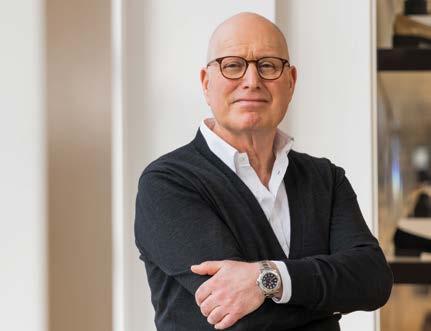
the 1980s when production of low technology, high labour cost products, like footwear, was rapidly moving the Far East. Since then, I have tried, not always successfully, to anticipate change and stay ahead of the game.
As Dune scaled, how did your role as founder change - and what was hardest to let go of?
I still get involved in the product and send design ideas to the buying team. They don’t always agree with my ideas but that’s okay. I also regularly attend range reviews. I am good at spotting what won’t sell. So, I haven’t let go of involvement in the product. Being the guardian of the brand I am still involved in some aspects of marketing. To be honest I was happy to let go of other areas of the business because I recognise our CEO and senior team are much better at managing these areas than me.
After 50 years in the industry, what still challenges or excites you day to day?
The main thing that excites me is making Dune London a truly global brand. The UK economy is sluggish and unfortunately, I can’t see any great change in the next few years. Our main growth is going to be international. Currently international retail sales accounts for 35% of our business. We want that to be 50% in the next three years. We are seeing very encouraging sales in the US. The Middle East is already our second biggest market after the UK with great growth potential. We are getting a tremendous reaction to our shoes and bags in so many other markets where there is a gap for an affordable luxury footwear and accessories brand like Dune London.
What do you think the next generation of fashion entrepreneurs will need to succeed that yours didn’t?
There is no doubt that in an uncertain and rapidly changing world the fashion business is generally getting more challenging. However, there are businesses and brands that buck the trend. Above all, fashion entrepreneurs will need to find a niche and a real point of difference in their products, in a growth sector of the fashion business, to succeed. They then must be ambitious (and look for global growth) and resilient, to handle the many global crises that will continue to buffet the global economy.
